Don’t call it a comeback: red lipstick is iconic and an incredibly easy way to perk up your complexion, whether or not you have time (or desire) to wear a full face of makeup. But where should you start on your quest for the best red lipstick? We’re breaking it all down in this buying guide—including comparing the best clean beauty lipsticks with conventional shades. Plus, SWATCHES.

By: Lisa Fennessy
IN THIS POST:
- Lipstick color 101: synthetic vs. natural dyes
- 15 clean beauty red lipsticks compared
- Best pink red lipstick
- Best brown red lipstick
- Best orange red lipstick
- Best true red lipstick
- Best matte red lipstick
- References
At the heart of the matter, clean beauty lipsticks are lipsticks that are made with good-for-you ingredients. And….scene. This article is done.
Jkjk. Let’s dive in.
Now, I know talking ingredients can get scary and intimidating, but really, I think it’s pretty obvious when you take a bird’s eye view like this. My take is, it’s really less about “shopping to avoid ingredients” and more about “choosing what ingredients you want to use” on your skin. (And I don’t know about you but I’ll take organic jojoba seed oil for $1,000, Alex.)
Lipstick color 101: synthetic vs. natural dyes
Let’s start this synthetic vs. natural convo with a caveat: we’re not living in a black and white world where anything natural automatically trumps anything synthetic. Pervasive marketing and greenwashing (and misinformation) may make it seem like it’s all or nothing, one or the other, or good or bad, but the TRUTH is that sustainability, personal choice and lack of information play into how each of us evaluates products.
This applies to any comparison between a conventional formula and a better-for-you option, from makeup and skincare to dairy alternatives and baby formula.
But we’re just gonna start with lipsticks. 😏 If you want more of the synthetics vs. naturals info, head here.
In conventional lipsticks, you will find a lot of petroleum-derived ingredients (like paraffin, synthetic wax and ozokerite), questionable preservatives (like BHT), ingredients with carcinogenic contamination concerns (like acrylates copolymer, synthetic wax and polyethylene) …and even plastics (like polyethylene, polybutene and nylon-12).
RELATED: TNK’s NO THANKS List—ingredients we skip altogether (and WHY).
On the flip side, in clean beauty lipsticks, you will find a lot of nourishing oils (like olive oil, coconut oil and jojoba seed oil), moisturizing butters (like shea and mango seed butter and cocoa seed butter), antioxidant-rich ingredients (like vitamin E and rosehip seed oil) and if you are lucky, even some third-party certified organic ingredients.
If only those were the *only* things to consider in lipstick, right? What we are talking about here are the base ingredients for a lipstick. What makes a lipstick glide, what gives it texture, what drives finish, what stops it from getting moldy or growing bacteria.
When we step into the world of clean beauty, there is a whole other conversation going on that revolves around COLOR. And this is where it gets fun because you get to choose what’s right for you.
There are basically three different ways to add color to a lipstick and they all have their strengths and weaknesses. Here we go…
Synthetic Dyes
Synthetic dyes are FD&C or D&C synthetic colorants. You will see them on an ingredient list like; CI 15850 (Red 7 Lake), CI 19140 (Yellow 5 Lake), CI 45410 (Red 28 Lake), CI 73360 (Red 30 Lake), CI 45380 (Red 22 Lake), etc.
PROS: These colorants deliver the reddest reds and the pinkest pinks. Typically, brands that use these dyes are able to achieve true reds while brands that opt to avoid fall short of true reds.
CONS: These colors, originally derived from coal tar and now petroleum (1), have been linked to cancer (1), neurotoxicity (2), genotoxicity (2) and concerns with long-term safety (3). Most dyes, including Yellow 5, have been banned in Europe (4).
CAVEAT (and it’s a big one): These dyes are typically used in very low percentages. They tend to show up last on ingredient lists, which means they make up the smallest volume percentage of that formula, as opposed to castor oil for example, which may show up first and takes up the most volume in that formula. I talked to RMS reps at an event one time and they said they use synthetic dyes in some of their lipsticks in something like .01%—although I can’t remember the exact amount.
Our thoughts are, if you choose a lipstick with synthetic dyes, you’re not instantly *throwing your life away*. There’s a lot to take into consideration like frequency of use, percentages, personal preference, etc. If you want a true red, this is the only ways you are going to get it. And since there are such small percentages of these dyes in even some more ethical beauty lipsticks, the impact is much more nominal.
RELATED: Synthetic vs. natural ingredients—which one is better for you?
Iron oxides / titanium dioxide / mica
These are natural elements that are found in the earth. You will see them on an ingredient list like: Ecocert iron oxides, Ecocert mica, Ecocert titanium dioxide, iron oxides, mica or titanium dioxide, or by their color codes, like: CI 77891 (for titanium dioxide) or CI 77492 (yellow iron oxide) or CI 77491 (red iron oxide).
PROS: They are natural elements that are generally considered safe to use.
CONS: When using natural elements like this, there’s the possibility of contamination with heavy metal and other impurities. Some brands will test for this; some won’t. You can always ask. And there are also ethical issues around fair working conditions when it comes to mining natural mica. This is often why many brands will choose to use synthetic mica over natural mica. This is a question you can ask brands too.
CAVEAT: Some of these natural elements can be sourced Ecocert certified, which ensures these ingredients have been third-party vetted with respect to human health and more.
RELATED: How to read a beauty label + understand beauty certifications.
Fruits / berries / botanicals
Fruits and berries meaning literally just that. You will see them on an ingredient list like: alkanet root, elderberries, bilberries (and so on).
PROS: These ingredients are generally considered safe to use.
CONS: It’s really hard to get a high color intensity when just using fruits and berries.
CAVEAT: We’ve found one brand that may have cracked the code. (Keep reading!)
If you’re feeling confused about these ingredients, you’re in good company. Even the certification bodies can’t decide. COSMOS won’t certify an ingredient list with synthetic colorants in it, but Credo Beauty will sell it based on their standards. It’s just another example of how the ethical beauty industry’s standards aren’t regulated, and you need to choose for yourself what you feel comfortable with (we dive more into that convo here).
15 clean beauty red lipsticks compared
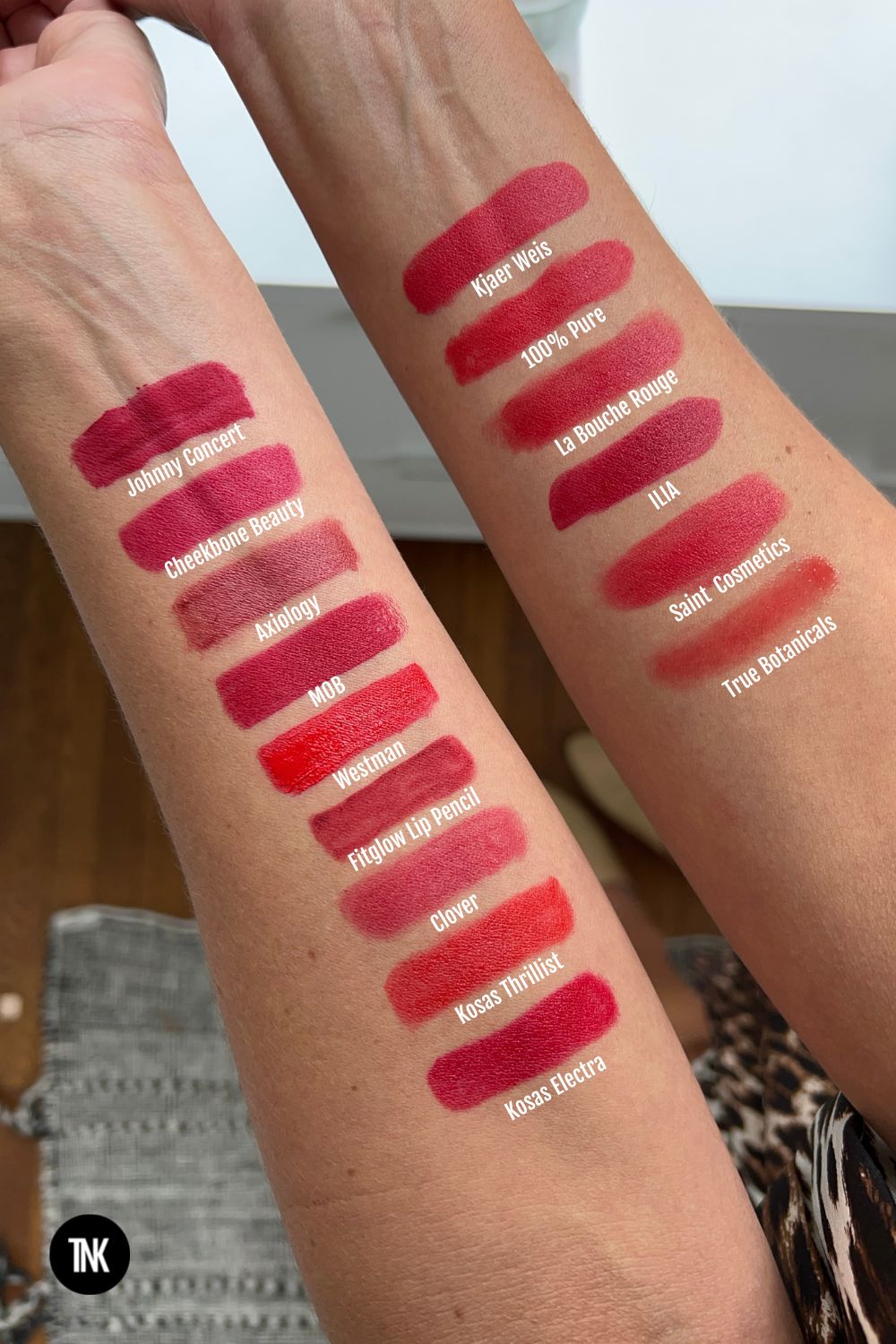
Sooo to help you choose the best clean beauty red lipstick for you, we rounded up 15 of the most popular shades of red and put them to the test here. Let’s first look at allllll the shades compared.
Best pink red lipstick

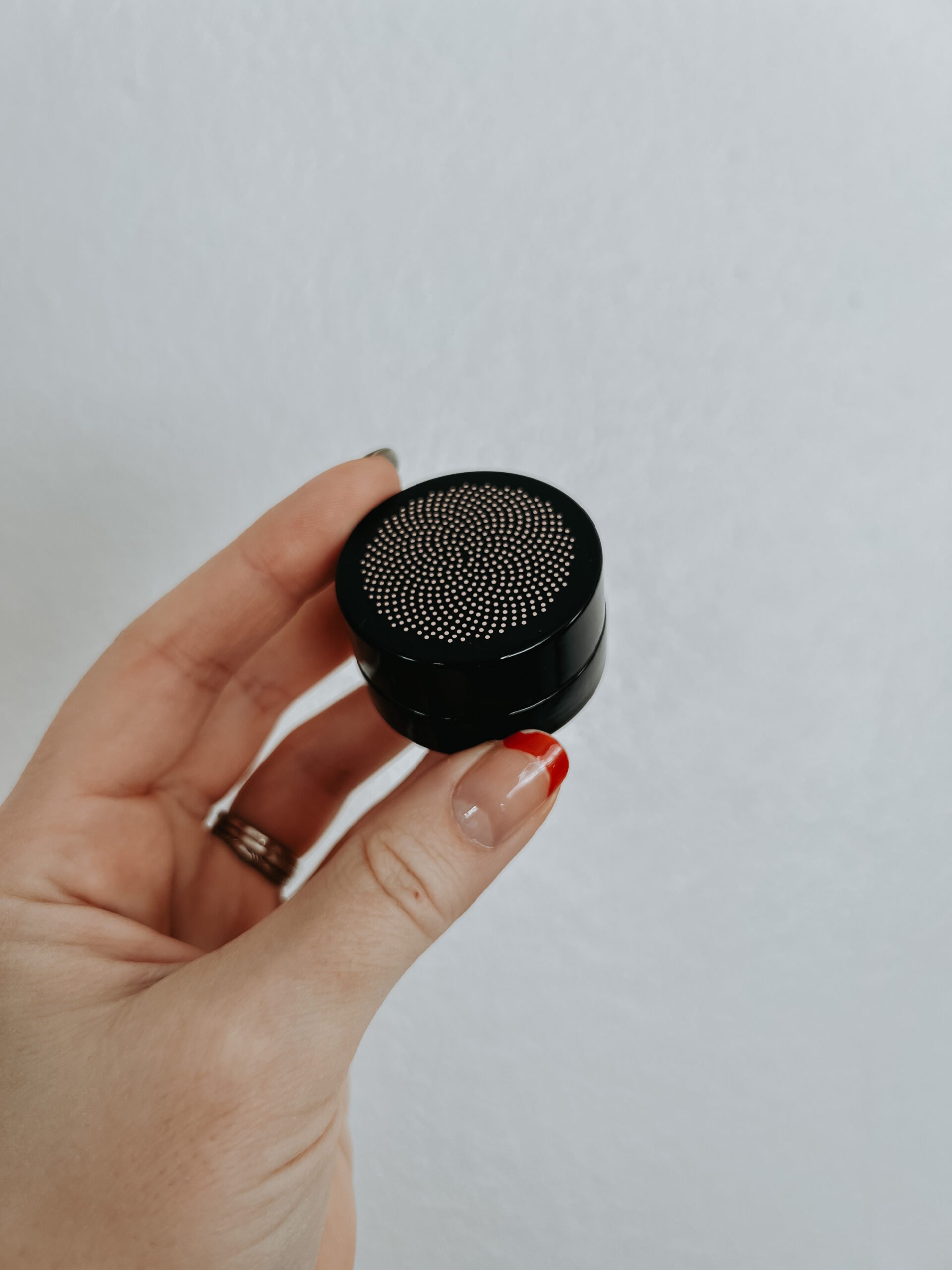
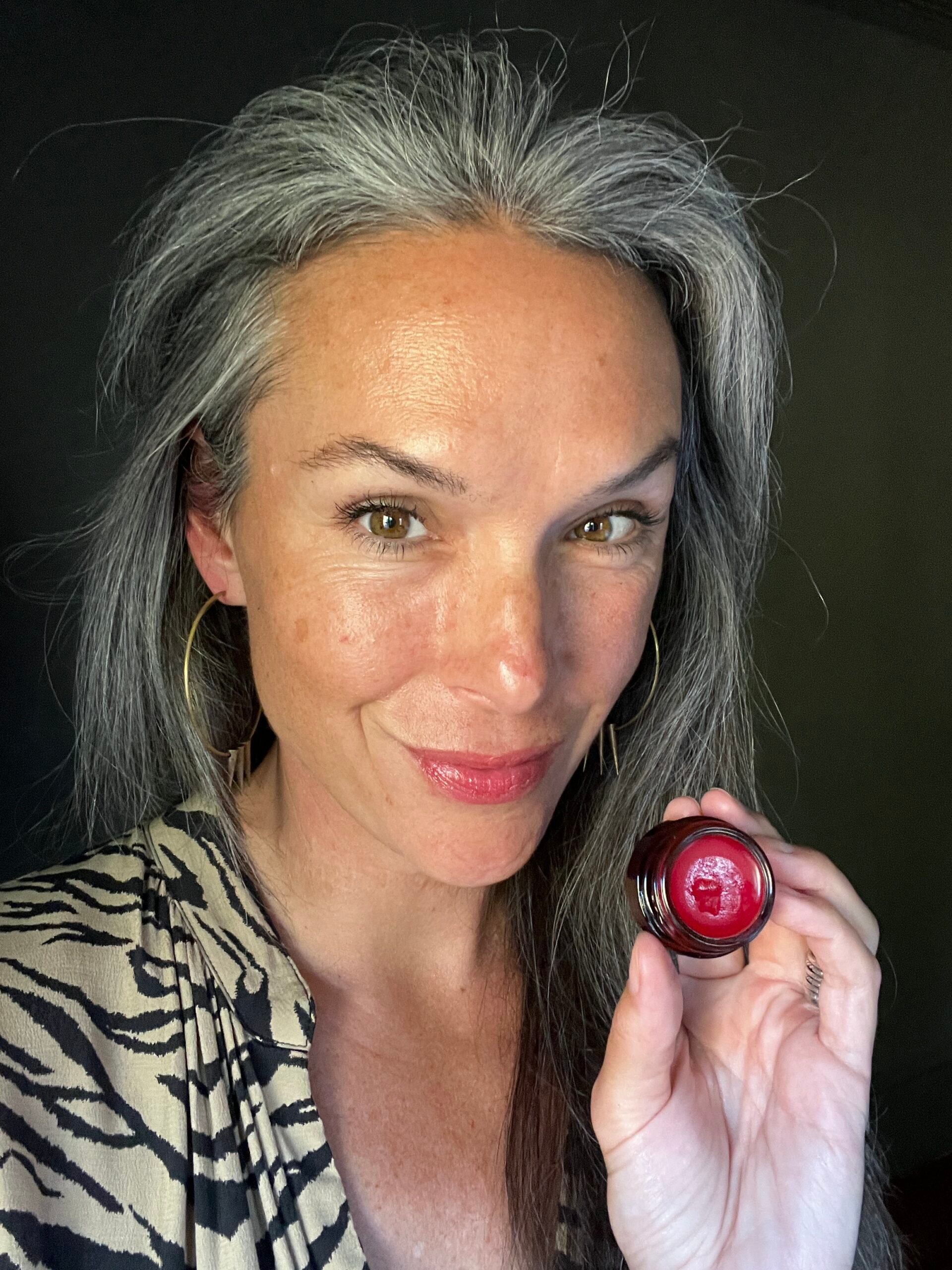
True Botanicals Moisture Lock Glossy Lip Balm in Love | $24
Shade: Sheer pink-red.
This is not technically a lipstick, but we wanted to include it here as it’s a new release for True Botanicals and it’s a nice option for someone looking for a wash of color.
True Botanicals says it treats lips with a flowering herb called spilanthes, known to help strengthen and firm lips. We like the flush of color and also that it has hyaluronic acid to help draw in hydration for the sensitive skin of the lip area.
True Botanicals uses a few ingredients to get the balm’s red color:
- Iron Oxide (CI 77491)
- Silica
- Melia Azadirachta Flower Extract
- Melia Azadirachta Seed Extract
- Coccinia Indica Fruit Extract
What we liked:
- Delivers ultra hydration
- Glossy finish
- Not sticky
- Sheer
- Light, pleasing scent
What we didn’t like:
- Not long lasting (rubs off easily and color disappears quickly)
- Have to apply with your finger
- We had to email TB to get the full ingredient list for the red shade LOVE; only the clear shade was listed on their website
Ingredients listed on website: Punica Granatum Sterols, Capryloyl Glycerin/Sebacic Acid Copolymer, Hydroxystearic/Linolenic/OleicPolyglycerides, Hydrogenated Vegetable Oil, Cocos Nucifera (Coconut) Oil*, Caprylic/Capric Triglyceride, HydrogenatedJojoba Oil, Cetearyl Olivate, Sorbitan Olivate, Ricinus Communis (Castor) Seed Oil, Butyrospermum Parkii (Shea) Butter*, Mangifera, Indica (Mango) Seed Butter, Persea Gratissima (Avocado) Oil, Sodium Hyaluronate, Eclipta Prostrata Extract, Vanilla Planifolia Fruit Extract, Tocopherol, Hydrogenated Castor Oil, Acmella Oleracea Extract, Melia Azadirachta Leaf Extract, Rosa Damascena Flower Oil, Moringa Oleifera Seed Oil
Save: Code TNK10 will save you 10% off your order at True Botanicals.

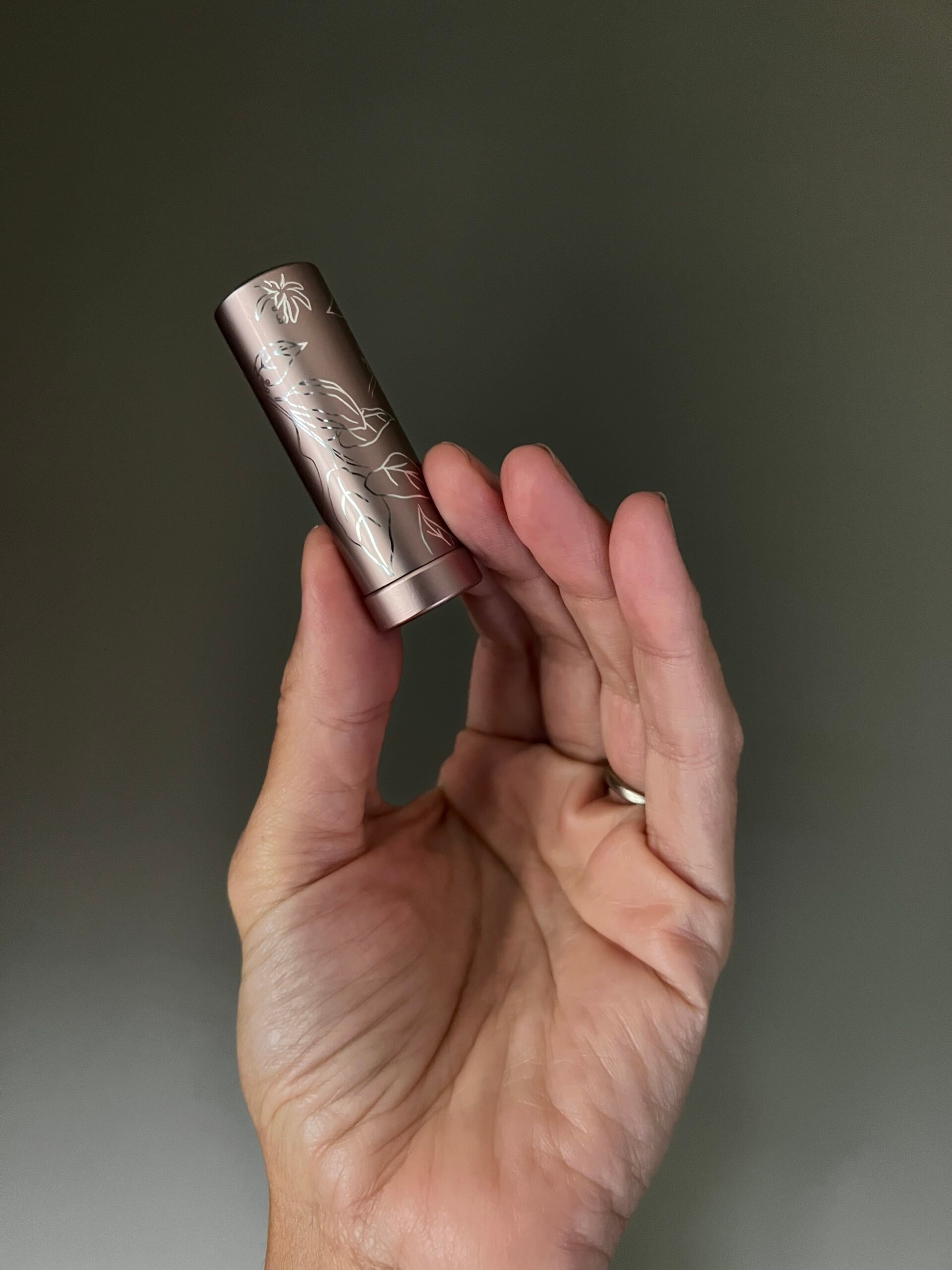
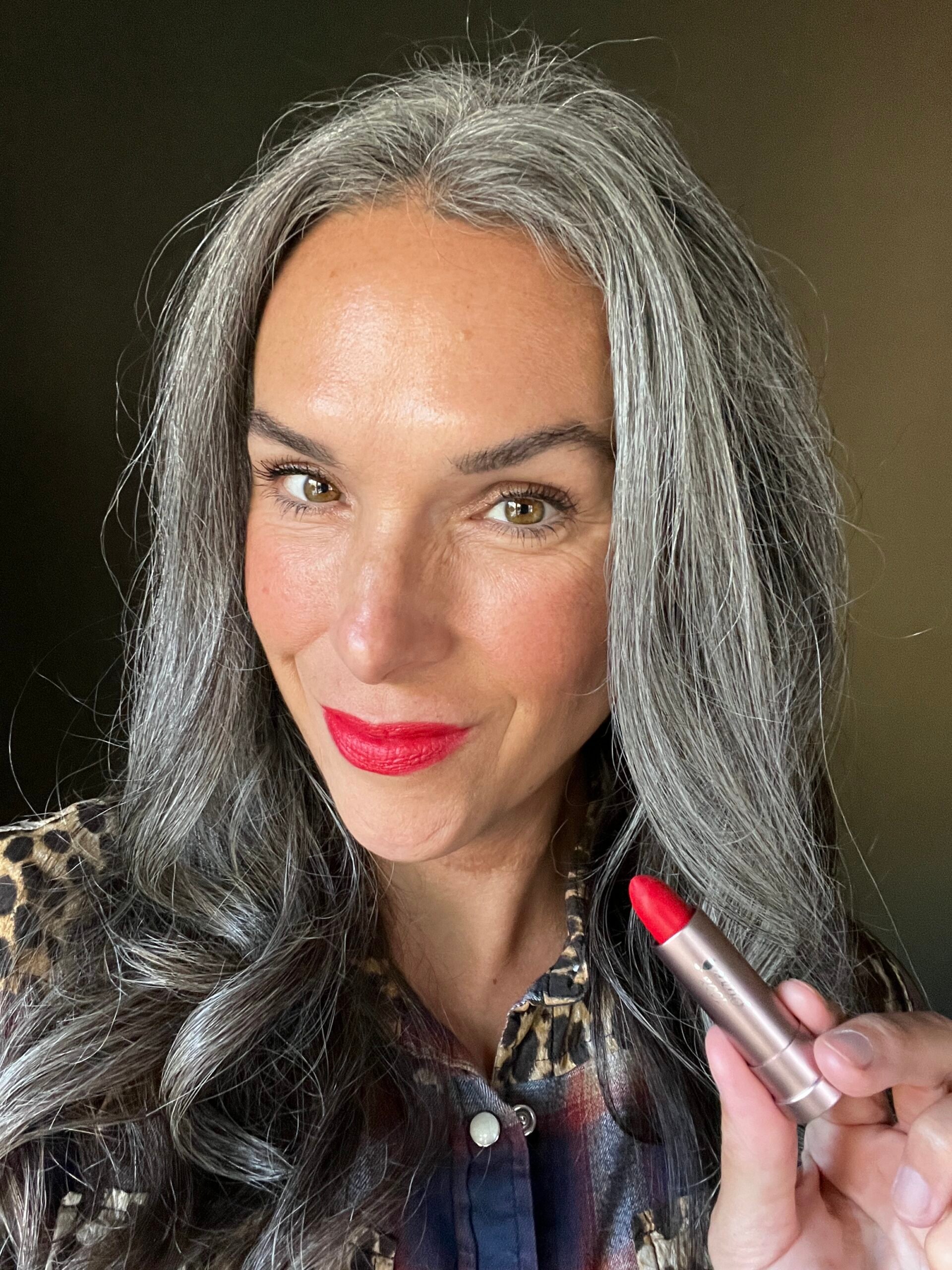
100% Pure Fruit Pigmented Cocoa Butter Matte Lipstick in Sonora | $28
Shade: The closest you can get to true red while still wearing a bit pink.
100% Pure is one of the few, if not the only, brand that has cracked the code when it comes to using fruit and vegetable pigments to deliver high impact color. I mean check out their Matte Lipstick in Sonora 👆. Ahhhho👀ogah.
We checked in with 100% Pure to ask how they get this high impact color using only fruits.
“We get our pigments from berries and vegetables through cold press technology which we have patents on (further details about this technology are proprietary information). However, as a broad overview, our pigments come from herbs, fruits, vegetables, and other plant sources. We collect the color in a couple of ways including by freeze-drying the material to use the crushed pigments and steeping the material in oil to extract the colorant.”
I would say the only downfall of this experience is the colors described on the site didn’t match my expectations. I tried to get their trueset red to test so I picked Sonora. It’s described as an “orange red,” but I would say it wears very pink (especially on me).
That being said, we can see this proprietary color technology yields big impact color, but I’m curious if it limits their color range…like I don’t see a true red option.
What we liked:
- High impact color with fruits and vegetables
- Matte finish
- Long lasting
- Base of a blend of cocoa butter, shea butter and vitamin E to moisturize and protect delicate lips
What we didn’t like:
- Basic packaging
- Can be a little drying
- Color descriptions are off
- Limited range of colors
Ingredients listed on website: Theobroma Cacao (Organic Cocoa) Seed Butter, Butyrospermum Parkii (Shea Butter), Extracts of Prunus Cerasus (Cherry) Fruit, Prunus Domestica (Plum) Fruit, Vitis Vinifera (Cabernet Grape) Fruit, Rubus Idaeus (Raspberry) Fruit, Vaccinium Angustifolium (Blueberry) Fruit, Rubus Fruticosus (Blackberry) Fruit, Prunus Persica (Peach) Fruit, Prunus Armeniaca (Apricot) Fruit, Solanum Lycopersicum (Tomato) Fruit/Leaf/Stem, Punica Granatum (Pomegranate), Cacao (Chocolate), Rosa Centifolia (Rose Petals) Flower, Lavandula Angustifolia (Lavender) Flower/Leaf/Stem, Oryza Sativa (Rice Starch), Tocopherol (Vitamin E), Euphorbia Cerifera (Candelilla) Wax, Silica, Rosmarinus Officinalis (Rosemary) Leaf Extract

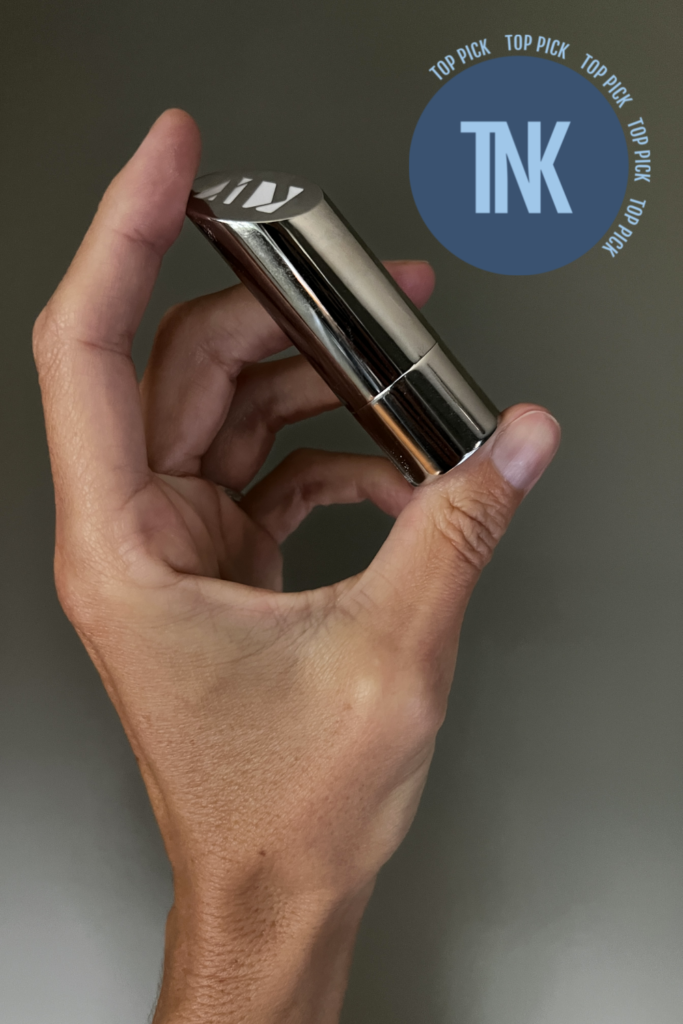
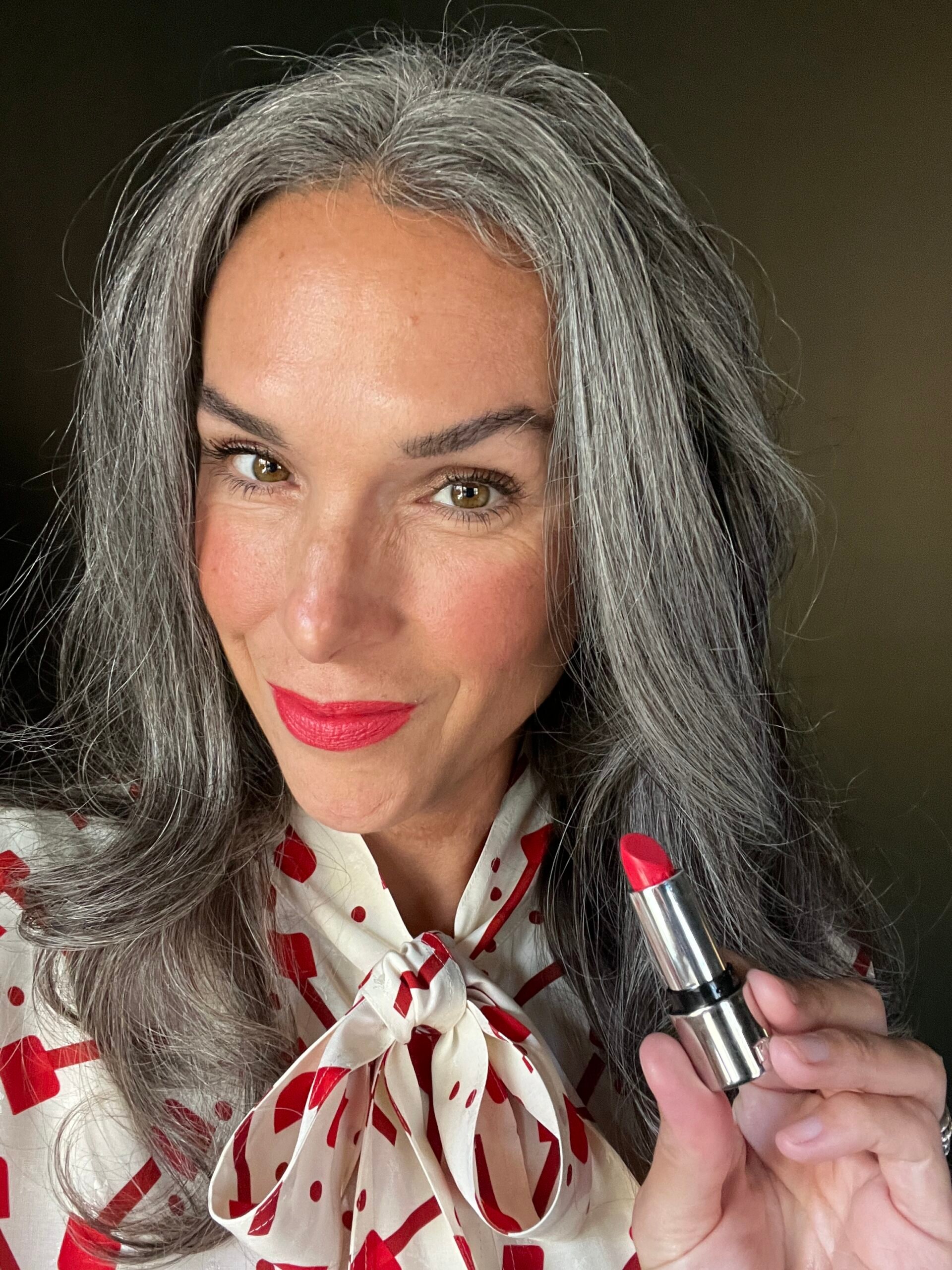
Kjaer Weis Red Edit Lipstick in Confidence | $48
Shade: Deep, magenta-pink red.
Holy Toledo, I love this color. And, also, welcome to one of my top picks.
Kjaer Weis uses many of the same ingredients in their lipsticks that they use in their skincare products. This means you are getting nourishing ingredients like biodynamically grown dioscorea batatas, organic shea butter, cold-pressed sunflower, rose hip and olive oils. I also love that most of their ingredients are organically grown.
Kjaer Weis uses synthetic dyes to pigment their lipstick, so we are getting a lipstick that has an incredibly thoughtful base combined with the highest color impact.
Also love that you can build it up from a flush to super bold. To illustrate this range, I’m wearing it here on my lips…and my cheeks.
And in case anyone asks, the fragrance listed in the ingredients is clearly laid out on their website: “Certified of natural origin and approved for use in organic products. Blend of essential oils and extracts. We are required to list it as fragrance as the exact breakdown is proprietary.
Understanding the potential concern about hidden ingredients in fragrance, we selected this blend because it is certified of natural origin (contains nothing artificial) and it is approved by the CCPB for use in organic products.”
What we liked:
- High impact color
- Dense color payoff
- Buildable color
- Gorgeous packaging
- Refillable packaging
- Lightweight
- Not drying
- Long lasting
- Demi matte finish
- Also has lip pencils to match
- Certified organic ingredients
- Even some biodynamically grown ingredients too
What we didn’t like:
- We had a hard time finding this shade when we were getting samples… it’s not in their normal lipstick range, so it’s easy to get confused
Ingredients listed on website: Ricinus Communis (Castor) Seed Oil•, Cera Alba (Beeswax)/Cire d’Abeille•, Caprylic/Capric Triglyceride, Cera Carnauba/Copernicia Cerifera (Carnauba) Wax/Cire de Carnauba•, Silica, Butyrospermum Parkii (Shea) Butter•, Coconut Alkanes, Mica, Olea Europea (Olive) Fruit Oil•, Rosa Rubiginosa (Rose Hip) Seed Oil•, Dioscorea Batatas Root Extract•, Coco-Caprylate/Caprate, Tocopherol, Helianthus Annuus (Sunflower) Seed Oil, Ammonium Glycyrrhizate, Fragrance/Parfum. +/- CI 15850(Red 6/Red 7 Lake), CI 77491 (Iron Oxide), CI 77492 (Iron Oxide), CI 77891 (Titanium Dioxide), CI 16035 (Red 40 Lake), CI 45410 (Red 27 Lake), CI 42090 (Blue Lake), CI 77499 (Iron Oxide). •Organically Grown/Biologique
Best brown red lipstick

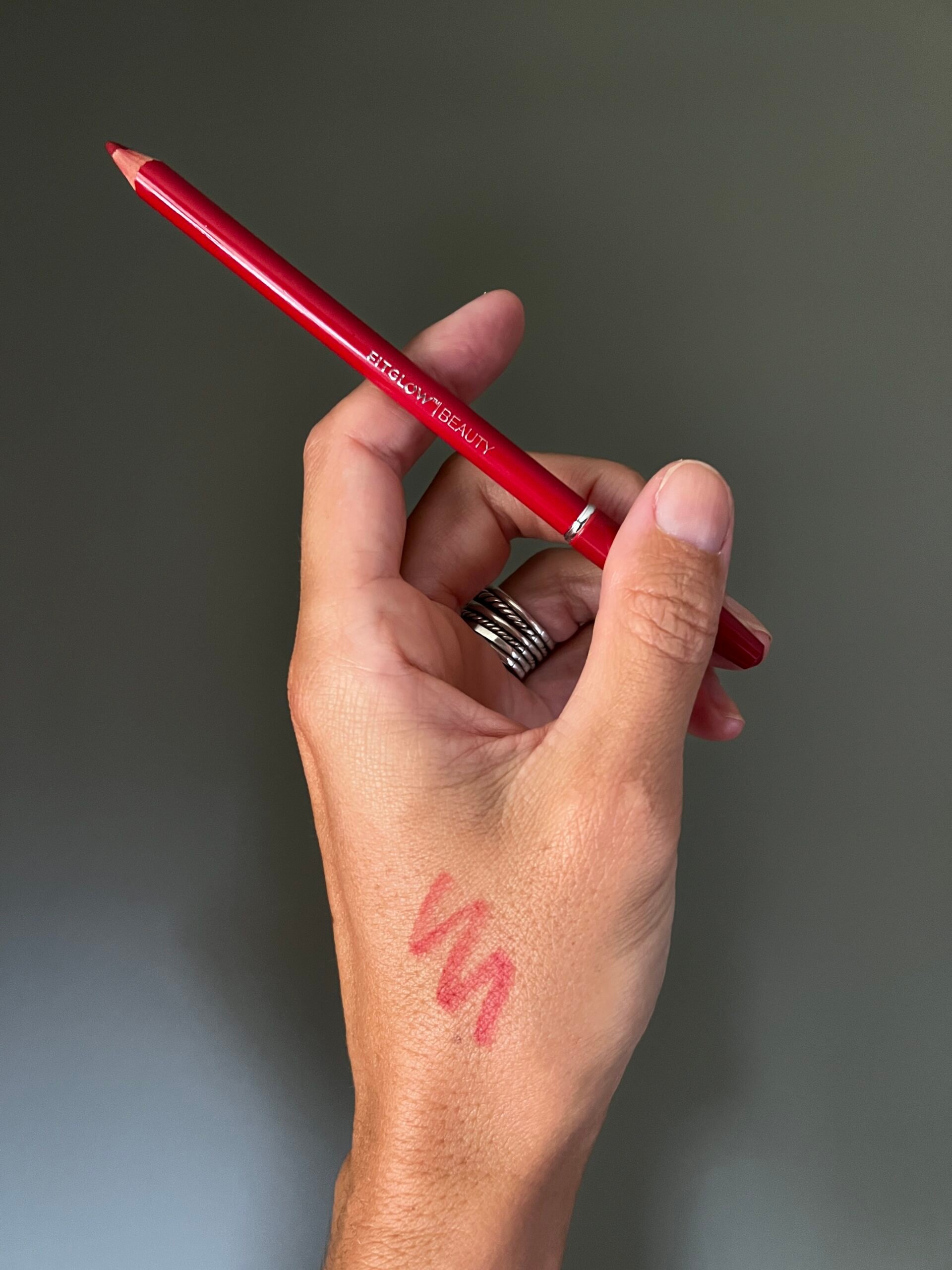
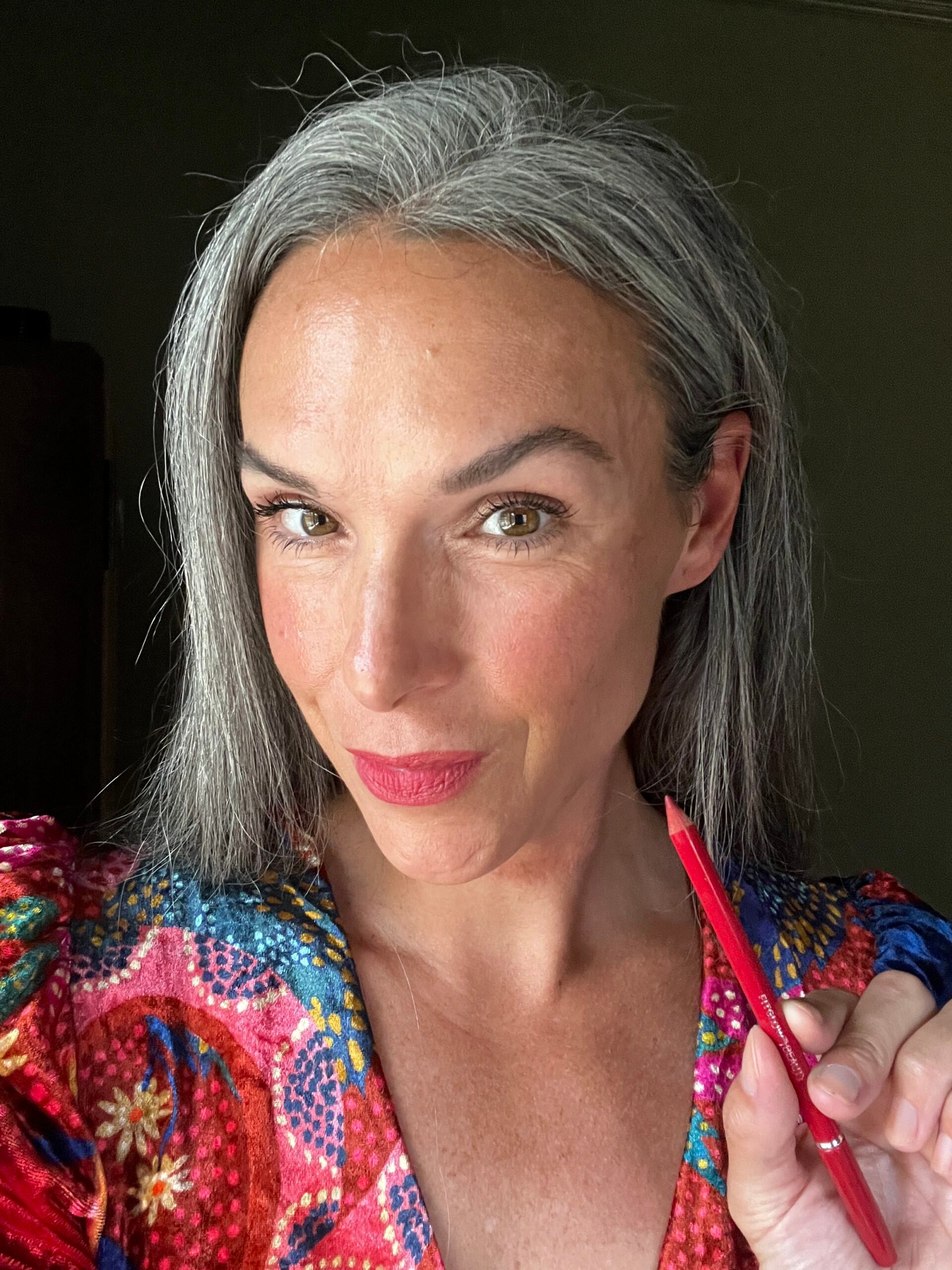
Fitglow Beauty Red Vegan Lip Liner | $24
Shade: Brick, brown-y red.
Fitglow Beauty is notorious for delivering cosmetics that not only color but also treat the skin with nourishing formulas. And we see that here too with…pretty much every ingredient listed.
Fitglow uses mica, titanium dioxide and iron oxides to color their cosmetics, which is why you see this lip pencil reads more of a brick red than a true red.
We love that you can also wear this alone as a stand alone color, that it comes with a precision brush on the other end, that it’s creamy and has an easy-to-apply consistency, and it has a matte finish.
What we liked:
- Not drying
- Easy to transfer
- Matte finish
- Precision brush included
- Can wear as a liner or on its own
- Some certified organic ingredients
What we didn’t like:
- Not a true red
Ingredients listed on website: Mangifera Indica (Mango) Seed Oil, *Limnanthes Alba (Meadowfoam) Seed Oil, *Rubus Chamaemorus Seed Oil (Cloudberry Seed Oil), *Hydrogenated Jojoba Oil, Caprylic/Capric Triglyceride, Euphorbia Cerifera (Candelilla) Wax, Silica ,Butyrospermum Parkii (Shea) Butter, Copernicia Cerifera (Carnauba) Wax, Tocopherol, *Helianthus Annuus (Sunflower) Seed Oil, Mica, Titanium Dioxide, Iron Oxides *CERTIFIED ORGANIC INGREDIENTS
Save: Code NEWKNEW20 will save you 20% sitewide at Fitglow.

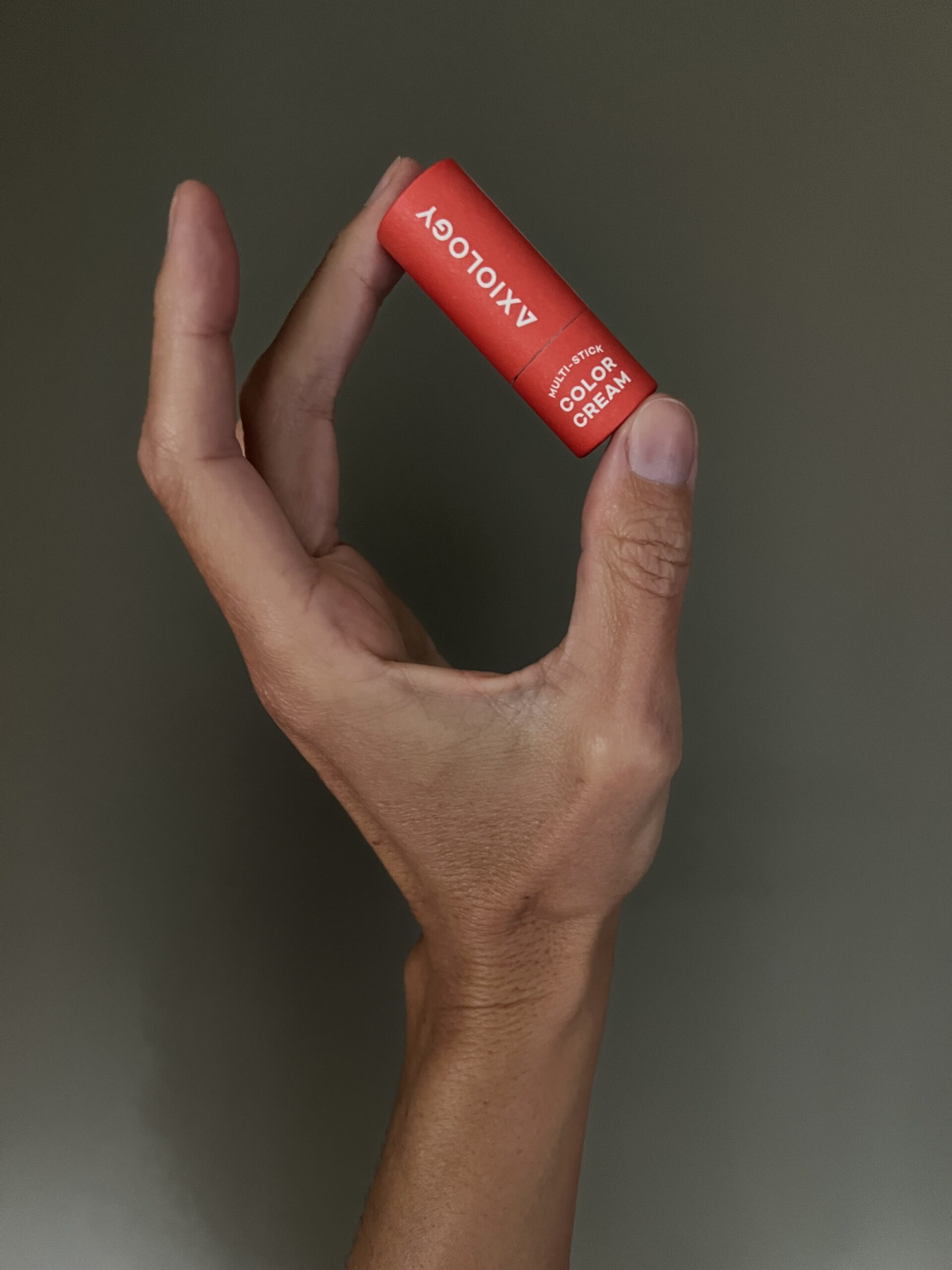
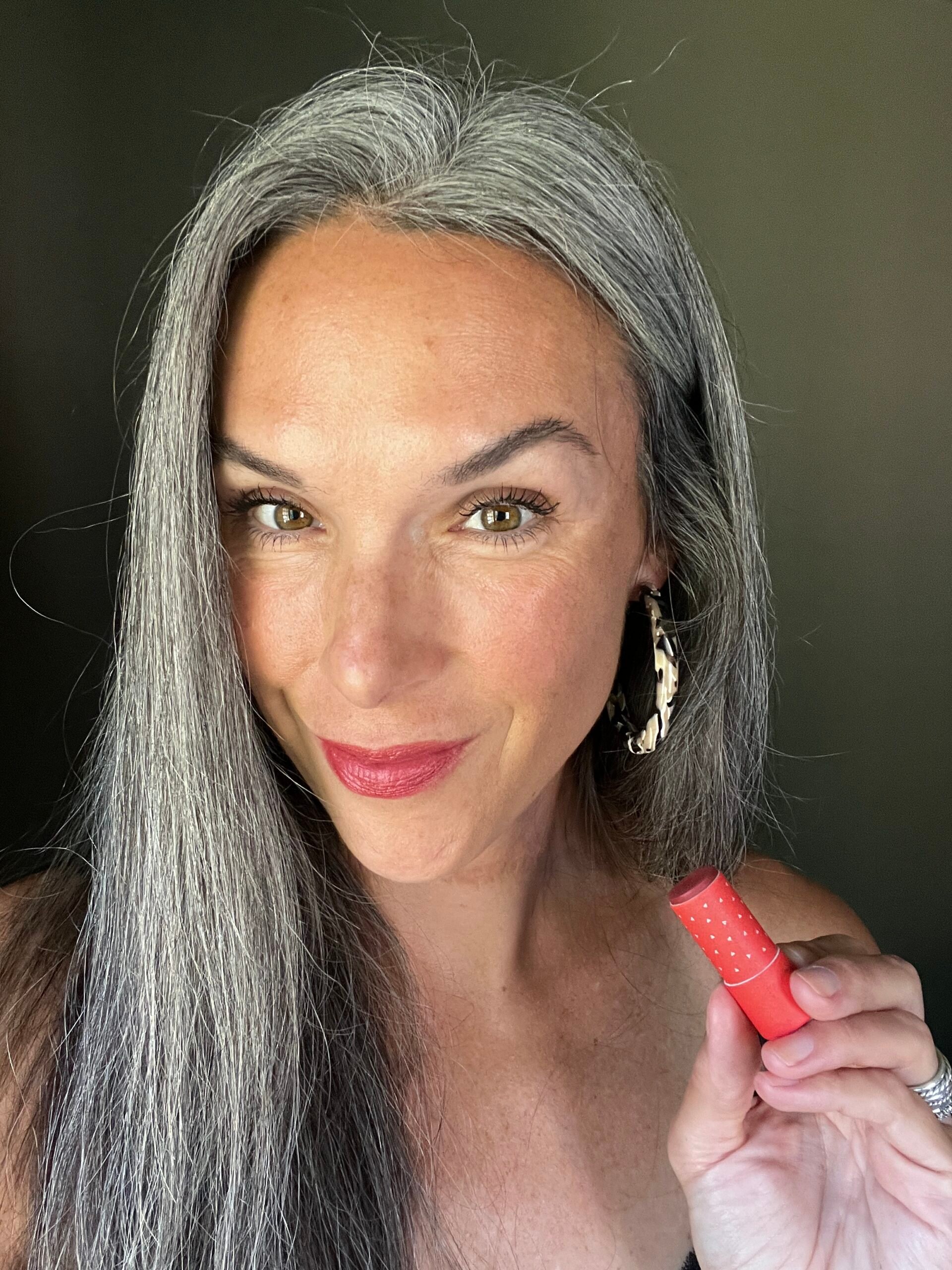
Axiology Multi Stick in True | $24
Shade: Brown red.
Love me a good multi stick and Axiology delivers with their 100% plastic-free, recyclable packaging.
Axiology says they use natural butters and oils such as soy butter and coconut oil to deeply penetrate skin for long-lasting hydration with a rich and creamy finish.
Axiology uses a mix of mica, titanium dioxide and iron oxides to color their multi sticks. They do not use synthetic dyes which is why their “true” red wears warmer and muted. Can be worn on lips and cheeks and eyes if you dare.
What we liked:
- Moisturizing
- How the color fades down to an even, just-bitten look
- The inclusion of certified organic ingredients
- Plastic-free packaging
- Recyclable packaging
- Moisturizing
What we didn’t like:
- If you push product up too much, it’s hard to get back down in the paper tube
- It’s much more subtle, so if you want a RED POP, this isn’t it
Ingredients listed on website: Cocos nucifera (coconut) oil*, Persea gratissima (avocado) oil, Ricinus communis (castor) seed oil*, Hydrogenated soybean oil, Helianthus annuus (sunflower) seed wax, Vitis vinifera (grape) seed oil*, Sambucus nigra fruit extract, Helianthus annuus (sunflower) seed oil, Tocopherol**, Azadirachta indica seed oil* May Contain: Mica (ci 77019), Titanium dioxide (ci 77891), Tin oxide (ci 77861), Iron oxide (ci 77491, ci 77492, ci 77499), Manganese violet (ci 77742), Synthetic fluorphlogopite, Silica. *organic
Save: Use code THENEWKNEW to save 20% at Axiology.
Best orange red lipstick

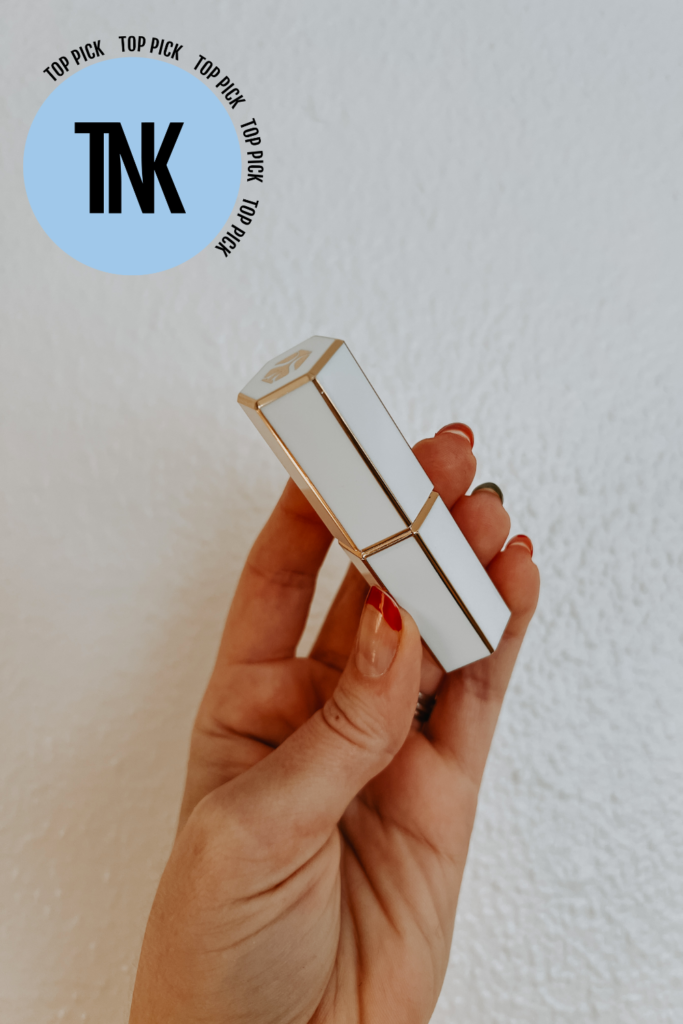
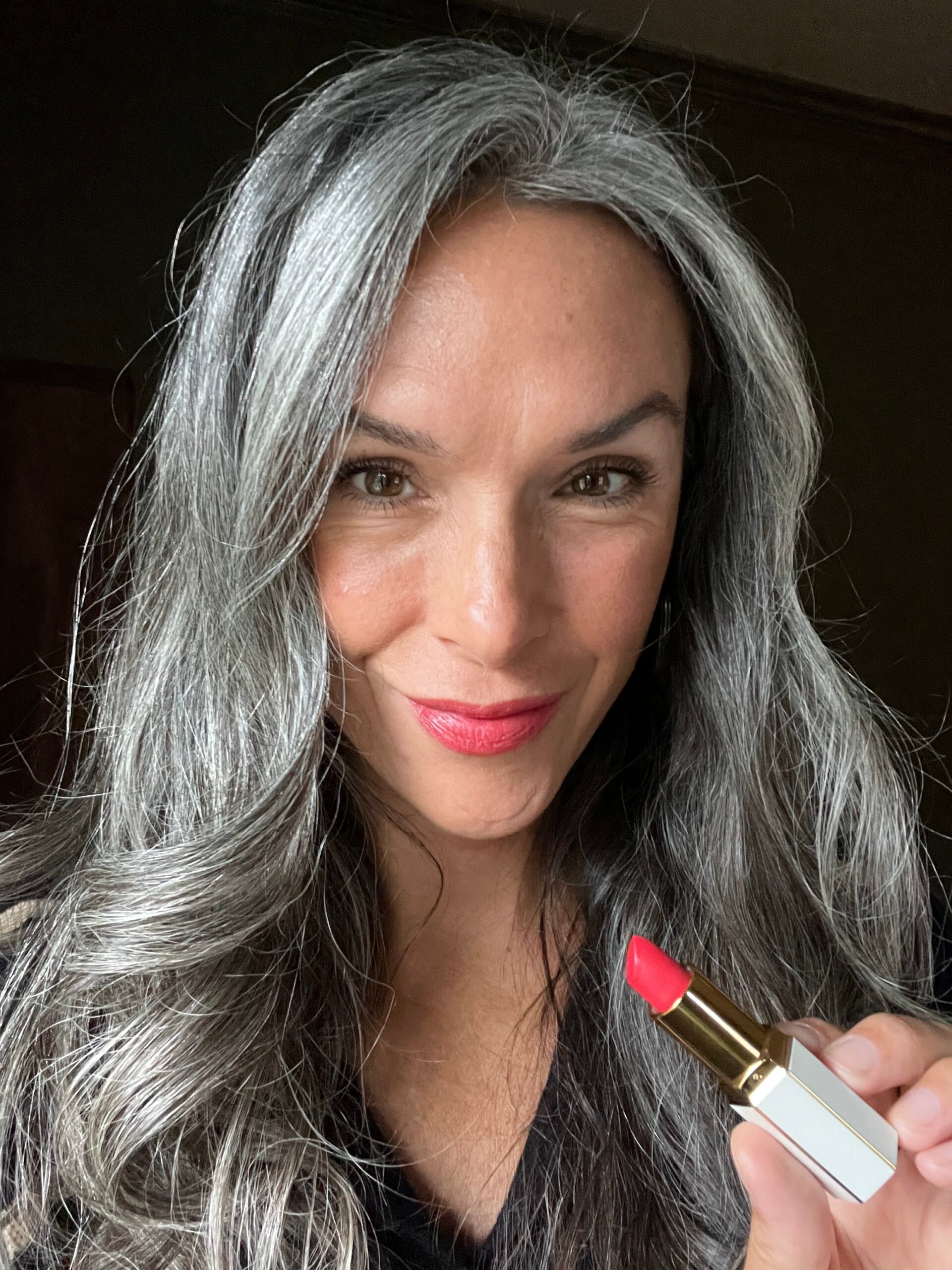
Saint Cosmetics Velvet Lip Crème in Singapore | $28
Shade: Warm-toned orange red.
This is another one of my top picks. It’s a cream lipstick you can apply in a single coat for a wash of color or layer to get more color payoff. The texture is creamy and moisturizing and finishes that way too (aka, this is not a matte lipstick). It’s more of an orange-red than a cool-toned or true red, in our experience.
What I love most about this lipstick is the ingredient list. Saint prioritizes organic ingredients, as well as ingredients that nourish like castor oil for moisture and to improve chapped dry skin, sunflower seed oil to protect from environmental stressors, and olive fruit extract and vitamin E to protect skin with antioxidants.
Saint uses mica, iron oxides and titanium dioxide to tint their lipsticks and what I really love about this is they source all of them Ecocert which ensures they’ve been third party tested (by one of the strictest certifications) with respect to human health and more.
Also, the packaging is gorgeous.
What we liked:
- A focus on organic base ingredients
- Sources Ecocert certified colorants
- Vibrant orange-red color
- Medium color payoff (can layer for a more of an intense look)
- Chic packaging
- Doesn’t dry out lips
- No real scent (always a pro for us)
What we didn’t like:
- Not long lasting
Ingredients listed on website: Organic Castor Oil, Caprylic/Capric Triglyceride, Organic Helianthus Annuus (Sunflower) Seed Oil, Euphorbia Cerifera (Candelilla) Wax, Organic Copernicia Cerifera (Carnauba) Wax, Organic Cera Alba, Cetyl Alcohol, Ricinus Communis (Castor) Seed Oil, Hydrogenated Castor Oil, Olea Europaea (Olive) Fruit Oil, Hydrogenated Olive Oil, Olea Europaea (Olive) Oil Unsaponifiables, Vanillin, Tocopherol, Gamma Decalactone, Gamma Octalactone, Ethyl Butyrate. May Contain (+/-): Ecocert Iron Oxides, Ecocert Mica, Ecocert Titanium Dioxide

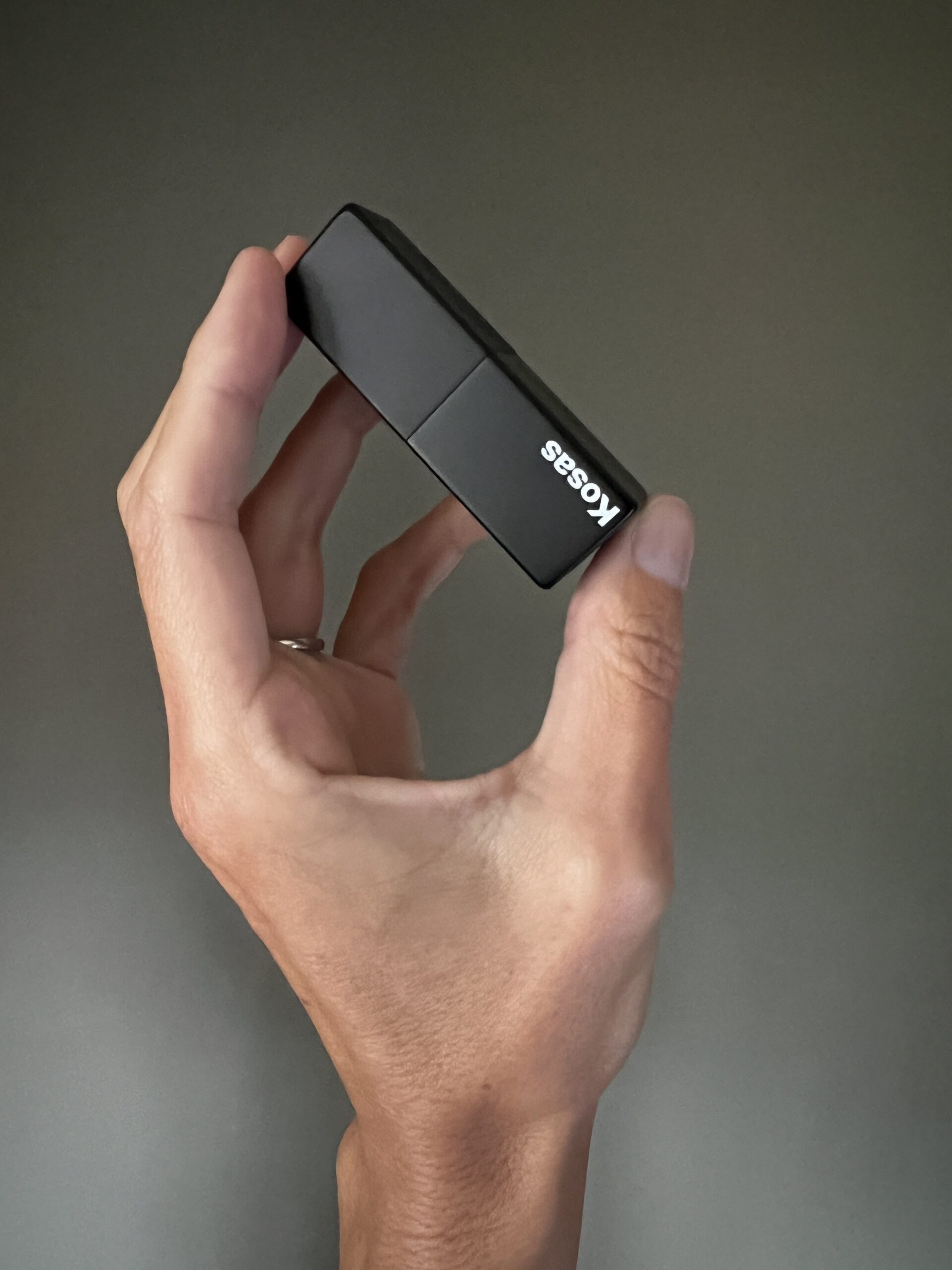
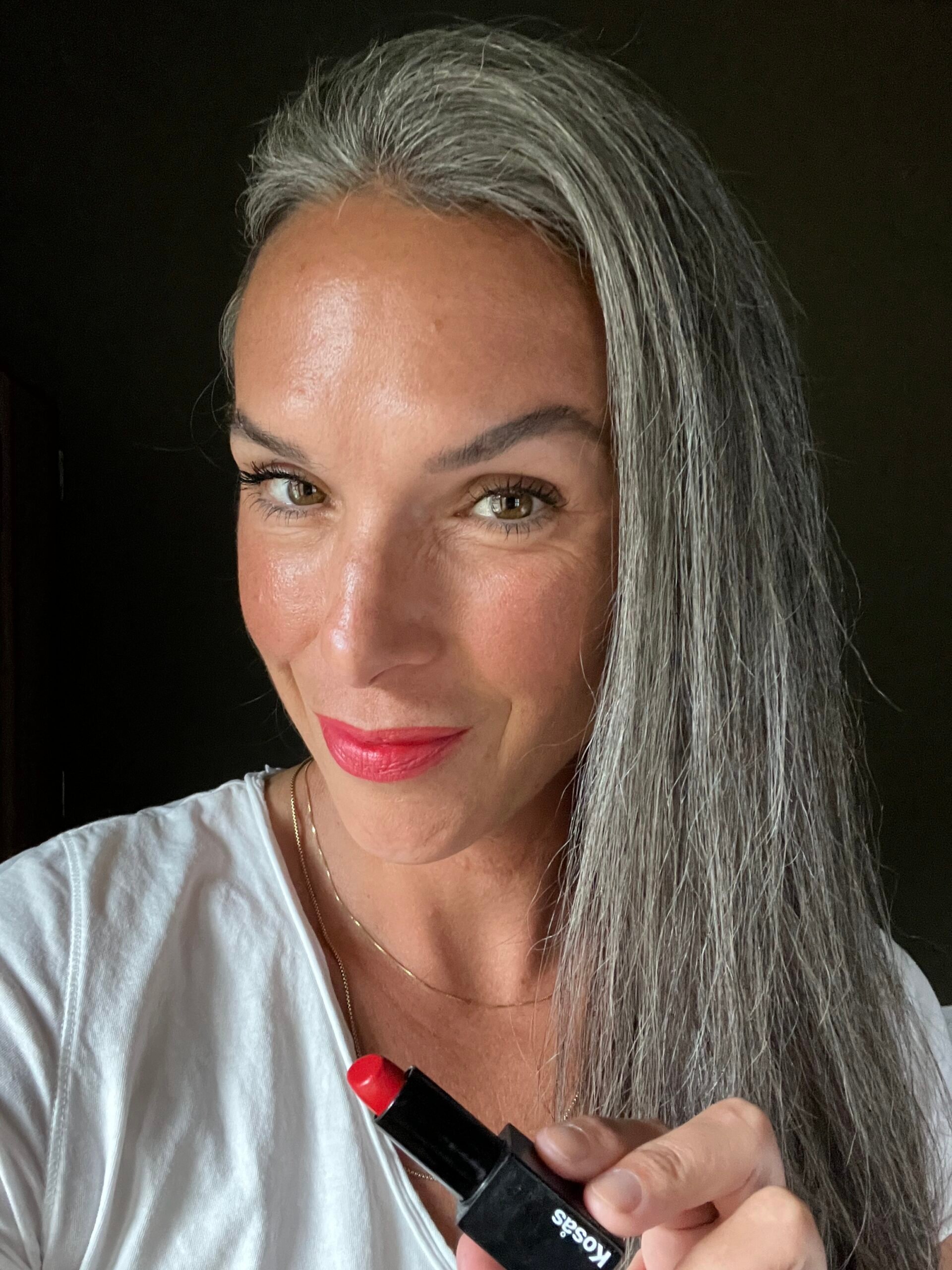
Kosas Weightless Lipstick in Thrillist | $28
Shade: The definition of orange-red.
Kosas says their lipsticks are made with mango seed butter to smooth fine lines, shea butter to soften, cocoa seed butter to support repair, rosehip seed oil to deliver antioxidants and jojoba oil to moisturize.
Kosas uses iron oxides, titanium dioxide and synthetic dyes to achieve maximum color pop. These formulas deliver moisture, color pop and that wow factor.
What we liked:
- Lightweight
- Moisturizing
- Semi gloss finish
What we didn’t like:
- Not a big focus on organic ingredients
- Not longwearing
Ingredients listed on website: Ricinus Communis (Castor) Seed Oil, Caprylic/Capric Triglyceride, Euphorbia Cerifera (Candelilla) Cera/Euphorbia Cerifera (Candelilla) Wax, Silica, Bis-Diglyceryl Polyacyladipate-2, Octyldodecanol, Lanolin Oil, Pentaerythrityl Tetraethylhexanoate, Beeswax, Copernicia Cerifera (Carnauba) Wax, Camellia Oleifera Seed Oil, Theobroma Cacao (Cocoa) Seed Butter, Vitis Vinifera (Grape) Seed Oil, Butyrospermum Parkii (Shea) Butter, Caprylyl Glycol, Carthamus Tinctorius (Safflower) Seed Oil, Citrus Aurantium Dulcis (Orange) Peel Oil, Ethylhexylglycerin, Helianthus Annuus (Sunflower) Extract, Mangifera Indica (Mango) Seed Butter, Microcrystalline Wax, Oryza Sativa (Rice) Bran Extract, Rosa Canina Fruit Oil, Rosmarinus Officinalis (Rosemary) Leaf Extract, Simmondsia Chinensis (Jojoba) Seed Oil, Tocopherol, Tocopheryl Acetate, Vanillin, Limonene, Linalool, [+/ -: Red 7 Lake (CI 15850), Red 28 Lake (CI 45410), Yellow 5 (CI 19140), Red 22 Lake (CI 45380), Red 30 Lake (CI 73360), Iron Oxides (CI 77491), Titanium Dioxide (CI 77891), Iron Oxides (CI 77492)]

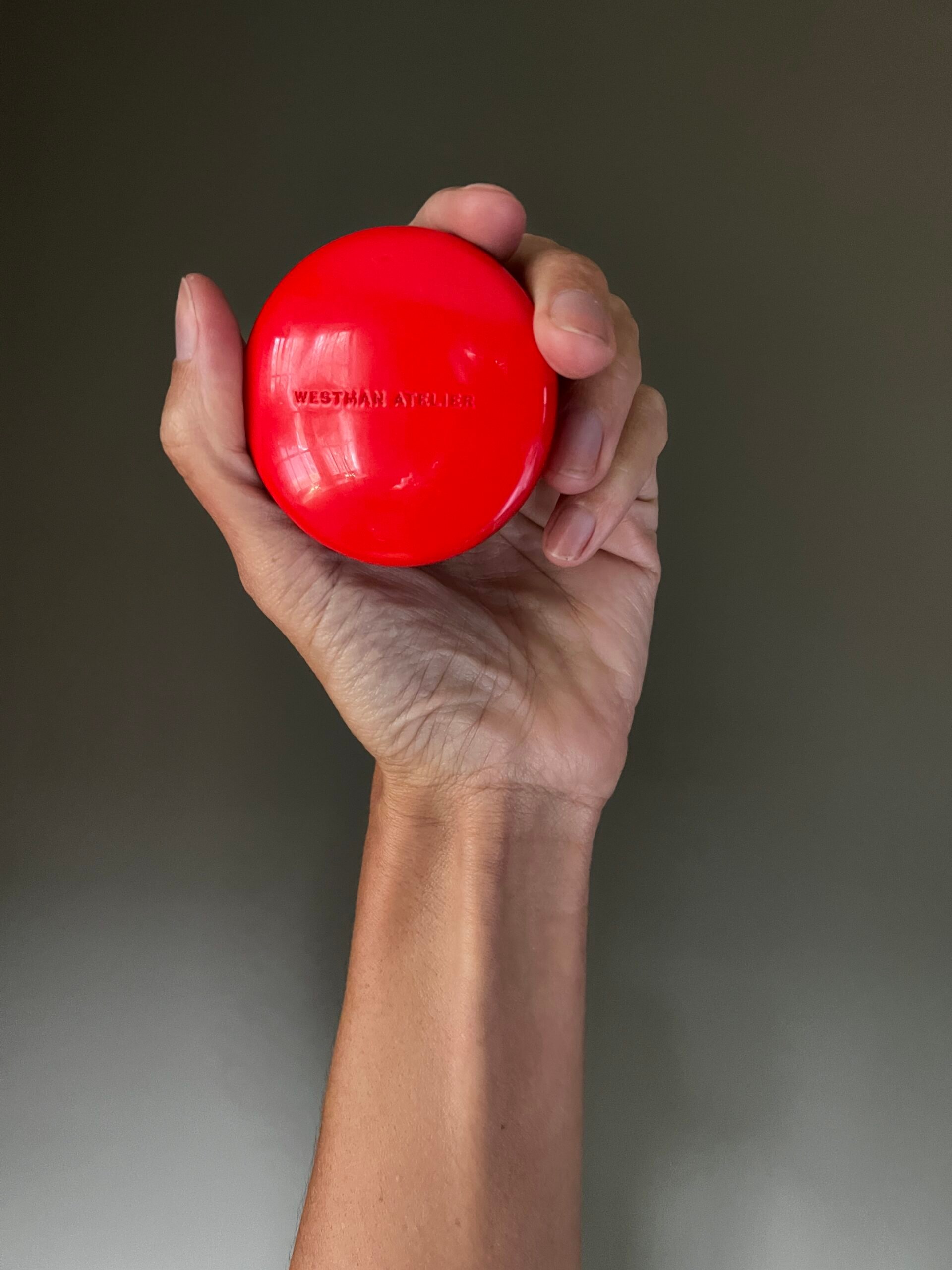
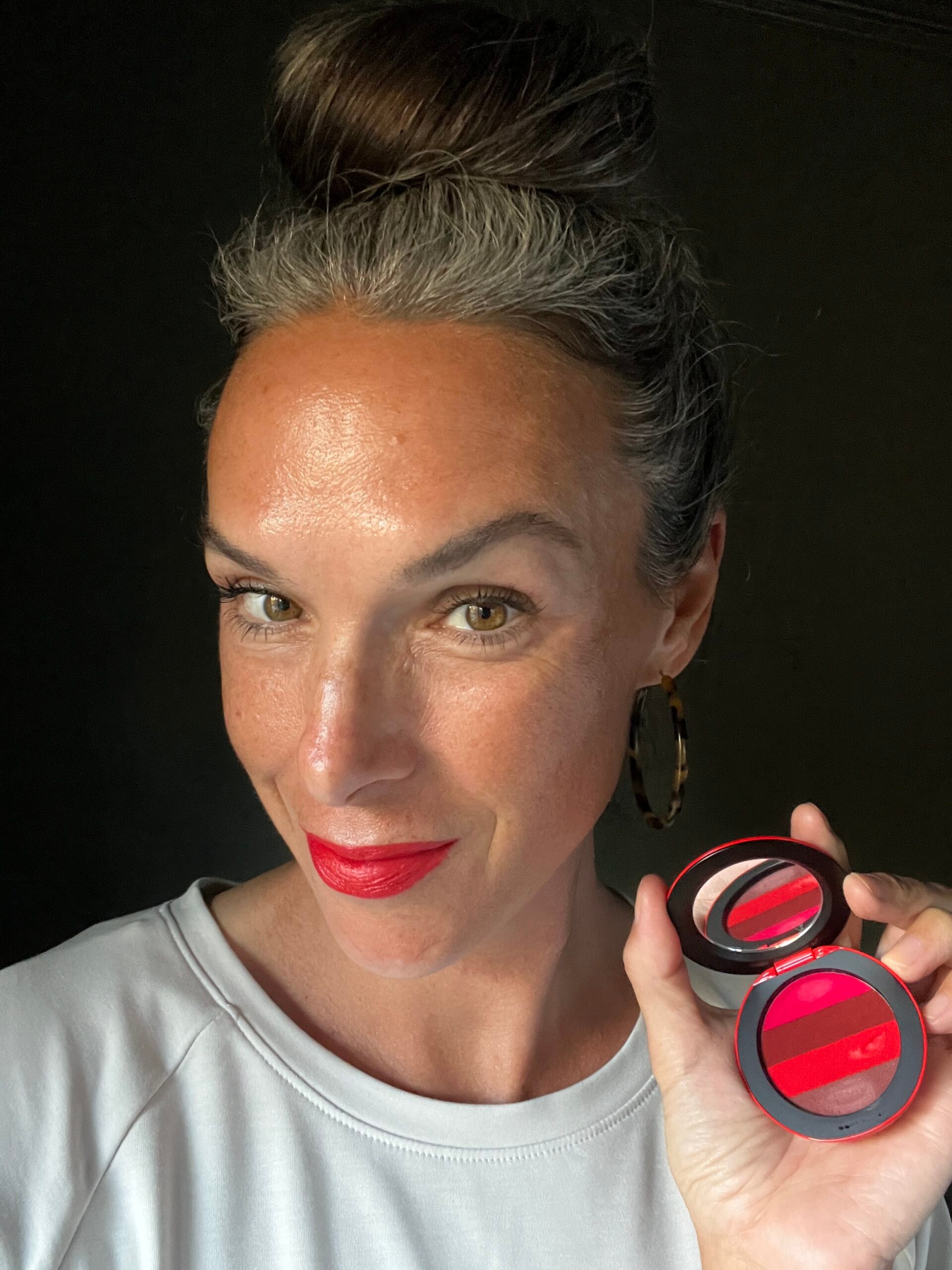
Westman Atelier Lip Suede in Les Rouges | $85
Shade: Warm-toned red.
Westman Atelier says they use 16.5% cold-pressed cherry oil and firming peptides that leave lips nourished and plumped in their Lip Suede (which comes in two palette options).
They also say they use “100% natural pigments,” but they don’t. They use a mix of mica, iron oxides, titanium dioxide and synthetic dyes to create their lip colors.
I’m obsessed with how these shades look on me.
What we liked:
- 4-in-1
- Can wear straight or mix and create so many shades
- Gorgeous, high impact color
- Chic packaging
- Demi-matte finish
- Full coverage
What we didn’t like:
- Price
- Not a focus on certified organic ingredients
- Doesn’t come with a lip brush
- Misleading marketing
- Hard to open
Ingredients listed on website: ricinus communis seed oil/ricinus communis (castor) seed oil, prunus avium seed oil/prunus avium (sweet cherry) oil, sclerocarya birrea seed oil, hydrogenated coco-glycerides, candelilla cera/euphorbia cerifera (candelilla) wax, copernicia cerifera cera/copernicia cerifera (carnauba) wax, hydrogenated vegetable oil, helianthus annnuus seed cera/helianthus annuus (sunflower) seed wax, lauroyl lysine, trihydroxystearin, mica, ethylhexyl palmitate, citrus noblis peel oil*/citrus noblis (madarin orange) peel oil, ascorbyl palmitate, tribehenin, sorbitan isostearate, lactic acid, palmitoyl tripeptide-1, limonene
May Contain: ci 15850/red 6, red 7 lake, ci 19140/yellow 5 lake, ci 42090/blue 1 lake, ci 45410/red 28 lake, ci 77491, ci 77492/iron oxides, ci 77891/titanium dioxide
Best true red lipstick

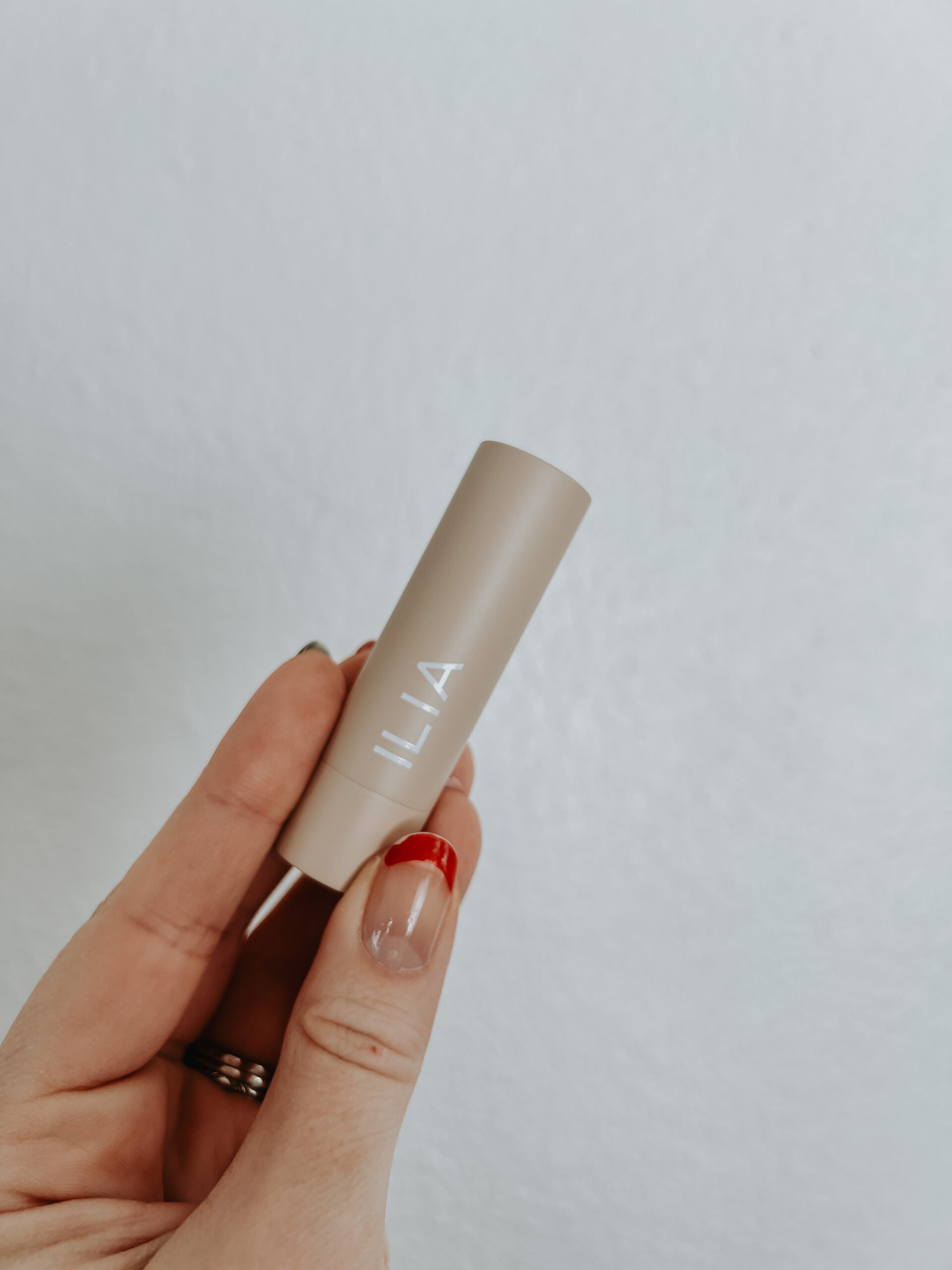
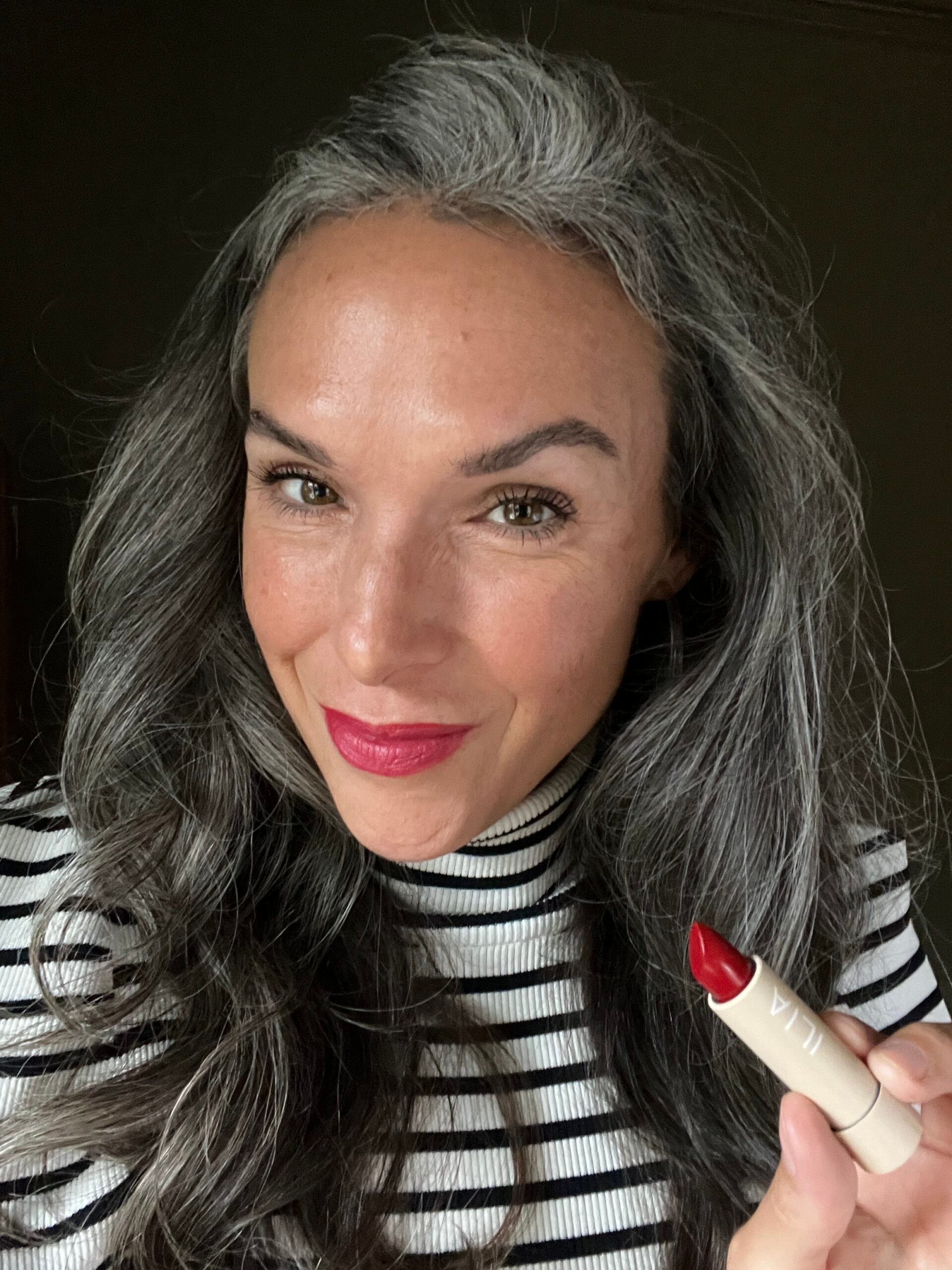
ILIA Color Block Lipstick in True Red | $28
Shade: Muted true red, with cool blue tones.
ILIA choses to tint their lipsticks with a combination of natural pigments and synthetic dyes, which is why we see such vibrant colors and intense color payoff. You want a TRUE red? You will find it here in ILIA.
Also love seeing healthy base ingredients to nourish like castor oil for moisture, apricot seed oil to boost elasticity and mango seed butter to keep lips plump and soft.
What we liked:
- Full coverage
- Intense color payoff
- Vibrant colors
- Matte finish
- Long lasting
- Does not dry out lips
- Lightweight
- Doesn’t bleed
- Good for you base ingredients
- A good, true red shade
- No discernible scent
What we didn’t like:
- Not moisturizing
- No certified organic ingredients
Ingredients listed on website: Ricinus Communis (Castor) Seed Oil, Caprylic/Capric Triglyceride, Candelilla Cera/Euphorbia Cerifera (Candelilla) Wax/Cire de Candelilla, Cera Carnauba/Copernicia Cerifera (Carnauba) Wax/Cire De Carnauba, Prunus Armeniaca (Apricot) Kernel Oil, Oleic/Linoleic/Linolenic Polyglycerides, Oryza Sativa (Rice) Bran Extract, Simmondsia Chinensis (Jojoba) Seed Oil, Jojoba Esters, Hydroxystearic/Linolenic/Oleic Polyglycerides, Helianthus Annuus (Sunflower) Seed Wax, Tocopheryl Acetate, Helianthus Annuus (Sunflower) Extract, Vanillin, Caprylyl Glycol, Ethylhexylglycerin, Tocopherol, Butyrospermum Parkii (Shea) Butter, Camellia Oleifera Seed Oil, Mangifera Indica (Mango) Seed Butter, Rosa Canina Seed Oil, Rosmarinus Officinalis (Rosemary) Leaf Extract, Theobroma Cacao (Cocoa) Seed Butter, Vitis Vinifera (Grape) Seed Oil, Rubus Idaeus (Raspberry) Seed Oil, Acacia Decurrens Flower Cera/Wax, Polyglycerin-3. May Contain/Peut Contenir (±): CI 77891 (Titanium Dioxide), CI 77491, CI 77492, CI 77499 (Iron Oxides), CI 15850 (Red 7 Lake), CI 19140 (Yellow 5 Lake), CI 45410 (Red 28 Lake), CI 73360 (Red 30 Lake), CI 77742 (Manganese Violet), CI 45380 (Red 22 Lake).

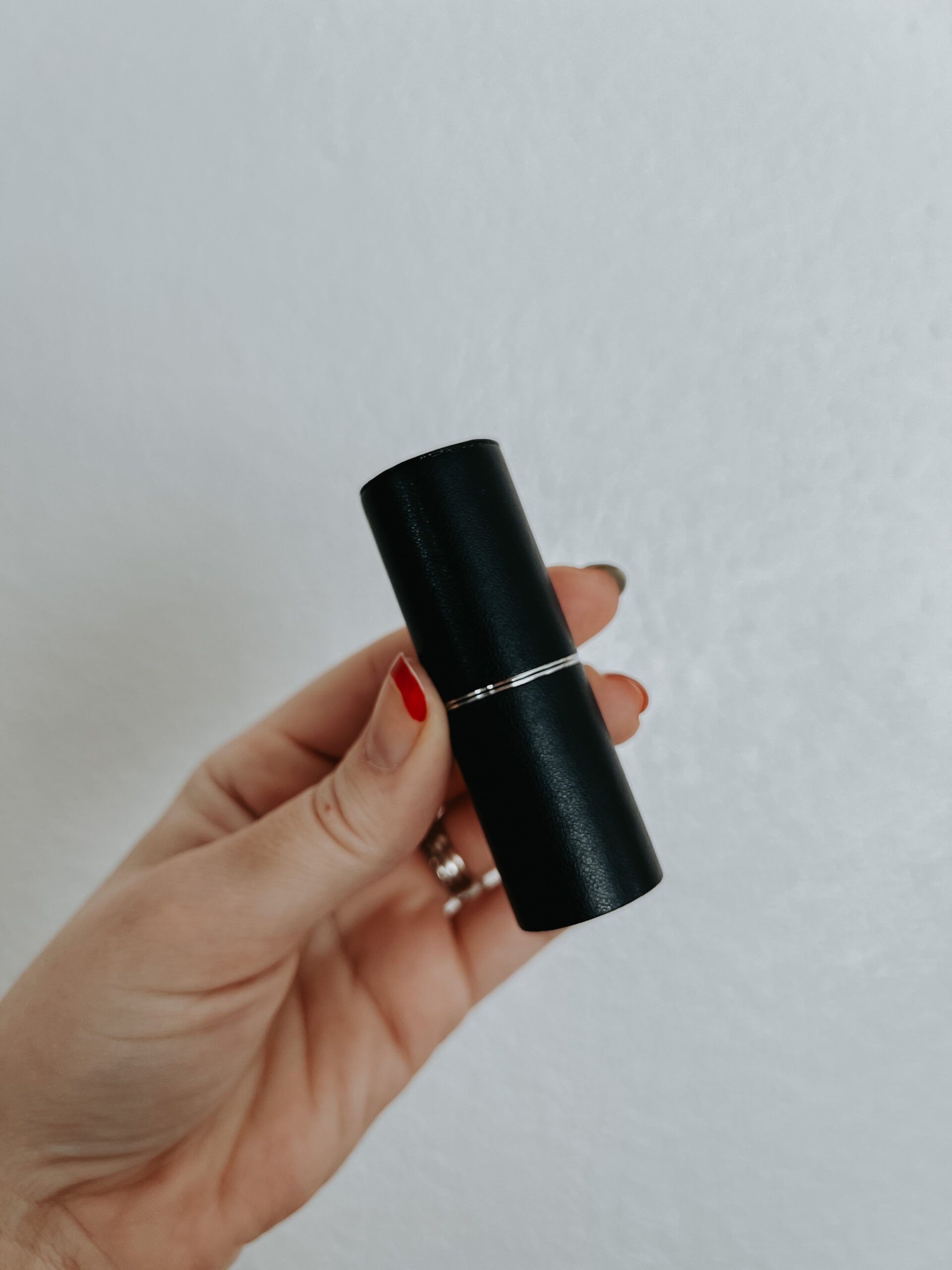
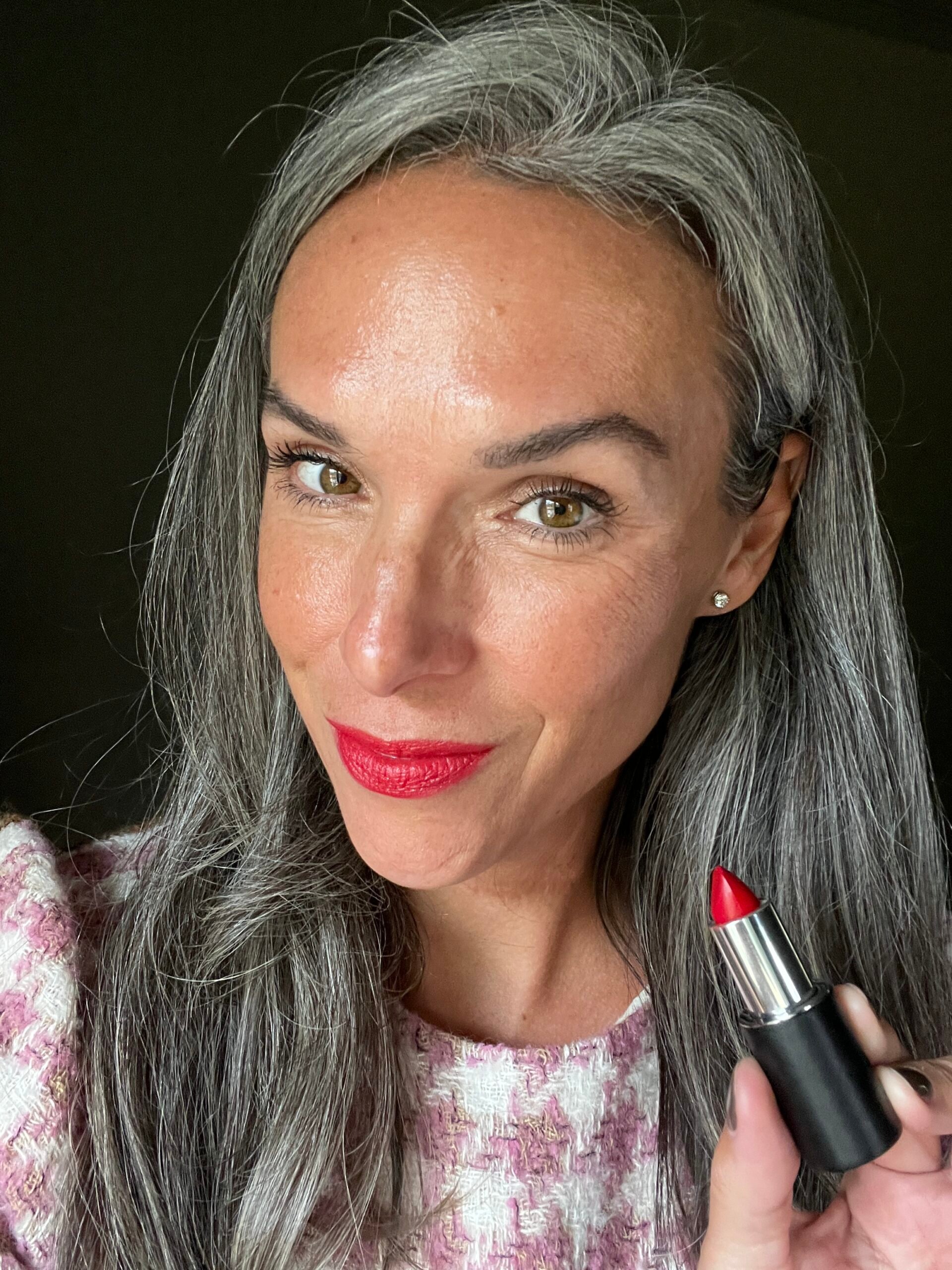
La Bouche Rouge in Le Rouge Self Service Matte | $40-$120
Shade: True, French-girl red.
La Bouche Rouge means “red lips” in French and this French-centric brand has taken chic + lipstick refills to a whole new level. They sell their lipsticks in a paper tube you can use on its own or you can invest in one of their handmade vegan lipstick cases in a variety of colors.
Their hero ingredient is their Saint Suliac Seaweed which La Bouche Rouge says “…hydrates and restores the lips to their natural color and redefines its contours.” It’s also formulated in a base of moisturizing ingredients like organic jojoba oil, squalane, shea butter and castor. We love that it also has hyaluronic acid to help hydrate.
Their matte lipsticks apply like a satin finish and then dry down to matte. La Bouche Rouge uses both titanium dioxide and synthetic dyes to deliver a banging color pop.
What we liked:
- The chicest refill packaging we’ve seen to date
- Plastic free vegan leather case
- The La Bouche Rouge team offers individual custom shade creation
- Matte but not TOO matte
- Weightless
- Not drying on lips
- No discernable scent
- An orange-red shade with warm tones of magenta
What we didn’t like:
- Price
- Takes a few swipes to get the full color reveal
Ingredients listed on website: Octyldodecanol, Helianthus Annuus (Sunflower) Seed Wax, Simmondsia Chinensis (Jojoba) Seed Oil, Lauroyl Lysine, Dicaprylyl Carbonate, Polyglyceryl-2 Triisostearate, Bis-Behenyl/Isostearyl/Phytosteryl Dimer Dilinoleyl Dimer Dilinoleate, Bis-Diglyceryl Polyacyladipate-2, Squalane, CI 15985 (Yellow 6 Lake), CI 19140 (Yellow 5 Lake), Butyrospermum Parkii (Shea) Butter, CI 15850 (Red 7 Lake), Stearalkonium Hectorite, CI 77891 (Titanium Dioxide), Stearic Acid, Propylene Carbonate, Tocopherol, Sorbitan Oleate, CI 45410 (Red 28 Lake), Menthol, Aluminum Hydroxide, Magnesium Hydroxide, Caprylic/Capric Glycerides, Ricinus Communis (Castor) Seed Oil, Stevioside, Helianthus Annuus (Sunflower) Seed Oil, Hydrolyzed Sodium Hyaluronate, Sodium Hyaluronate, Hydrogenated Castor Oil, Undaria Pinnatifida Extract
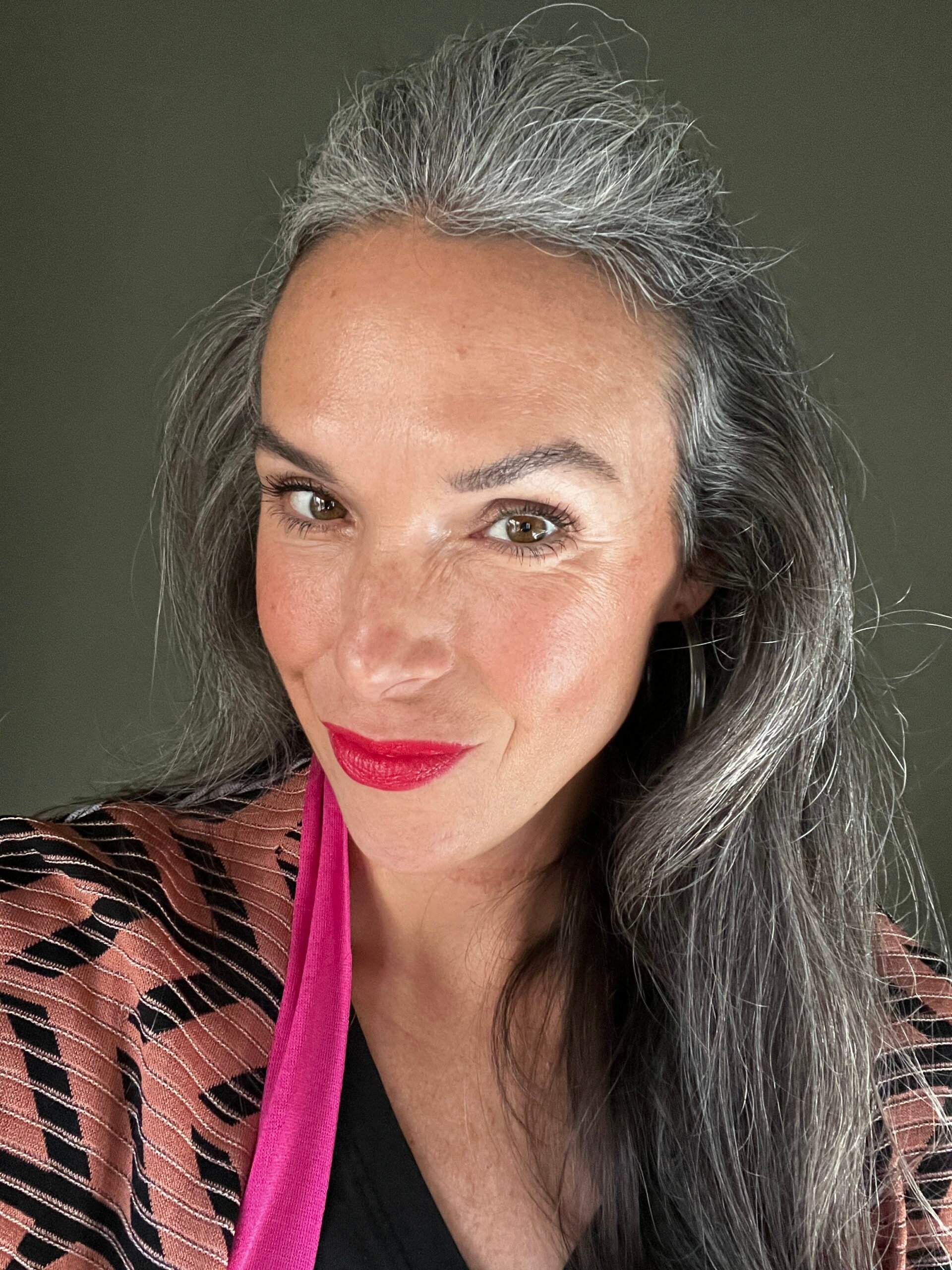
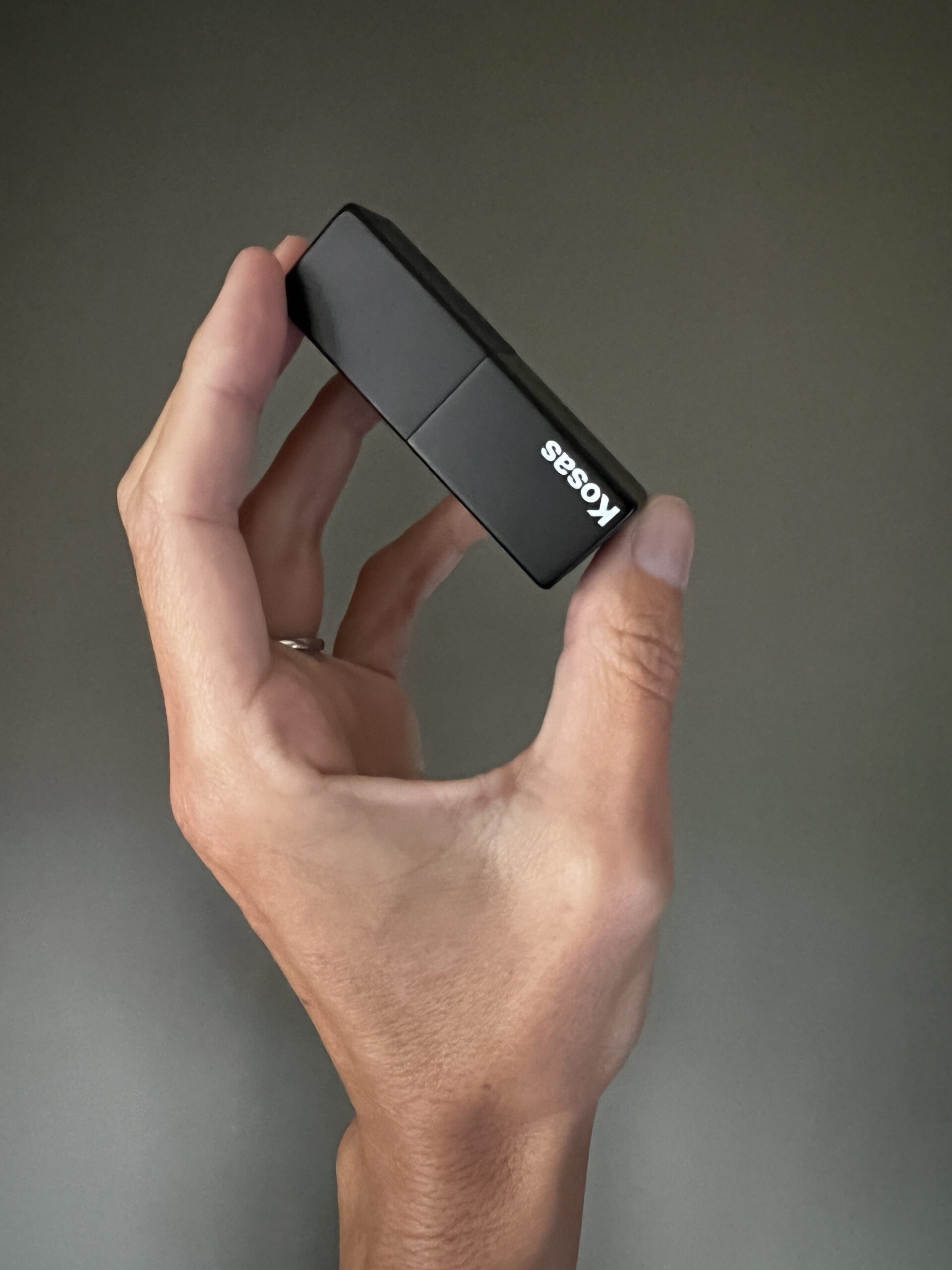
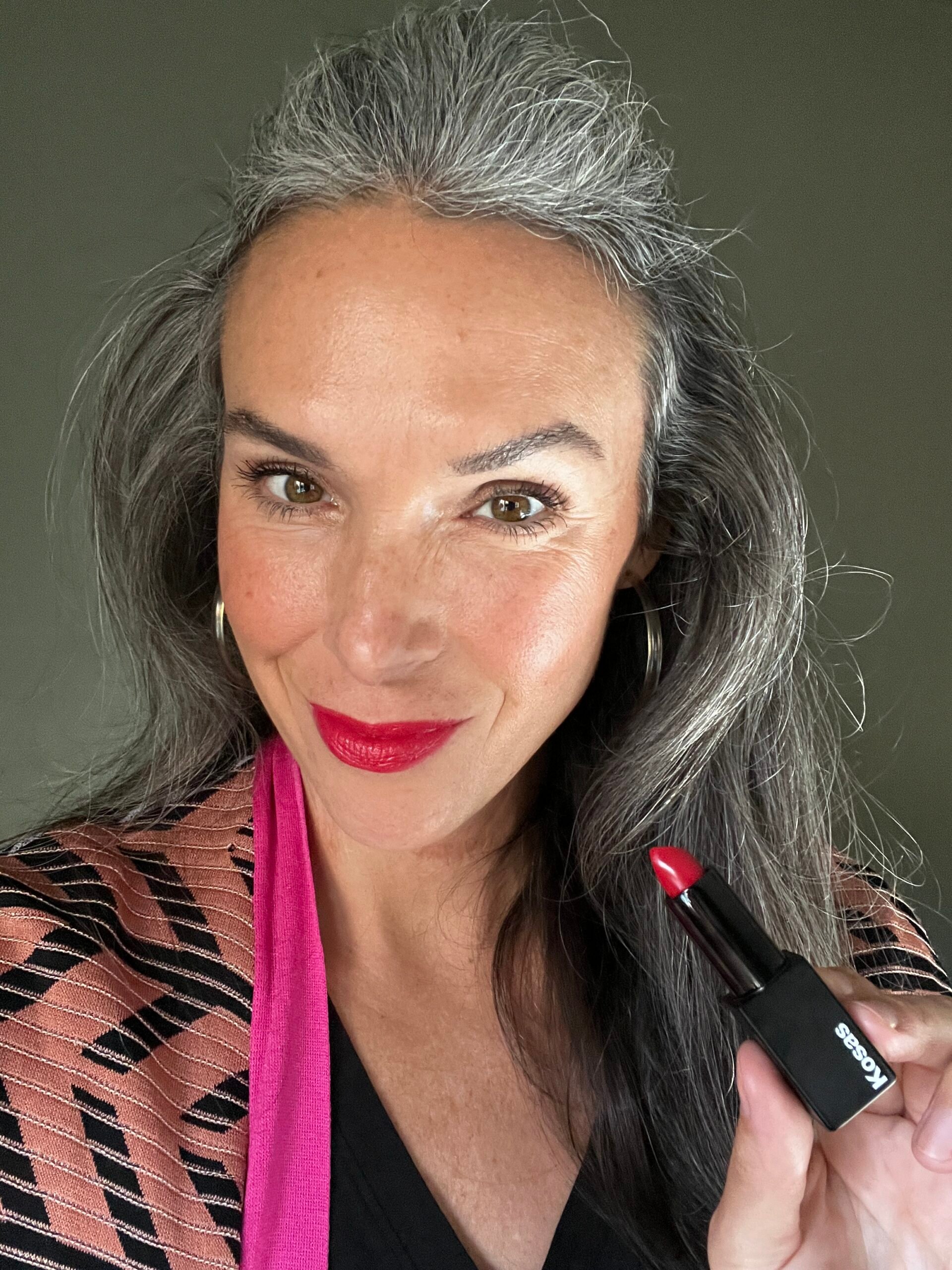
Kosas Weightless Lipstick in Electra | $28
Shade: True, deep, cool red.
Skip back up here for the breakdown on Kosas’ lipsticks, but had to show you this second red color from the brand, which is a cool-toned true red.

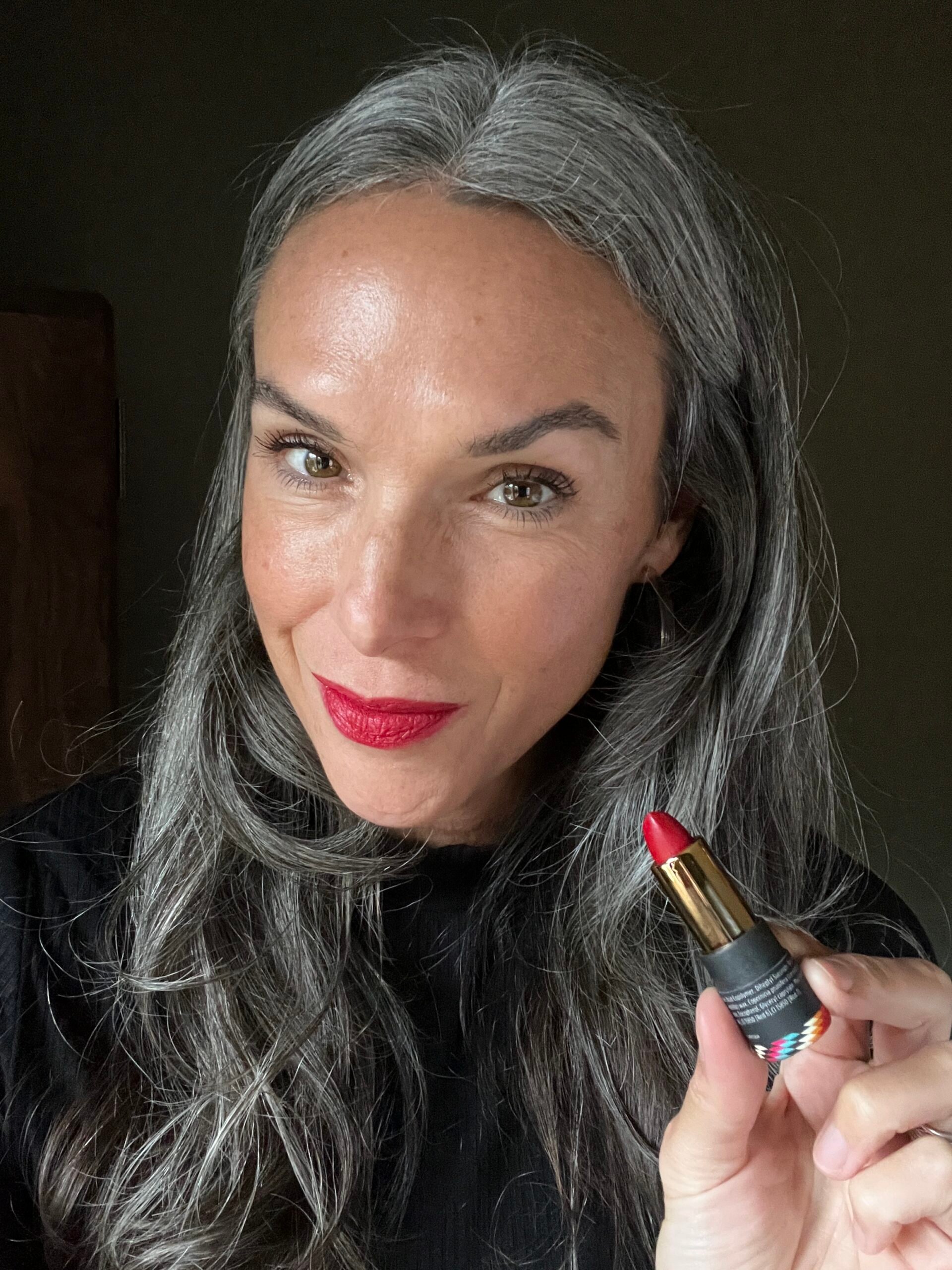
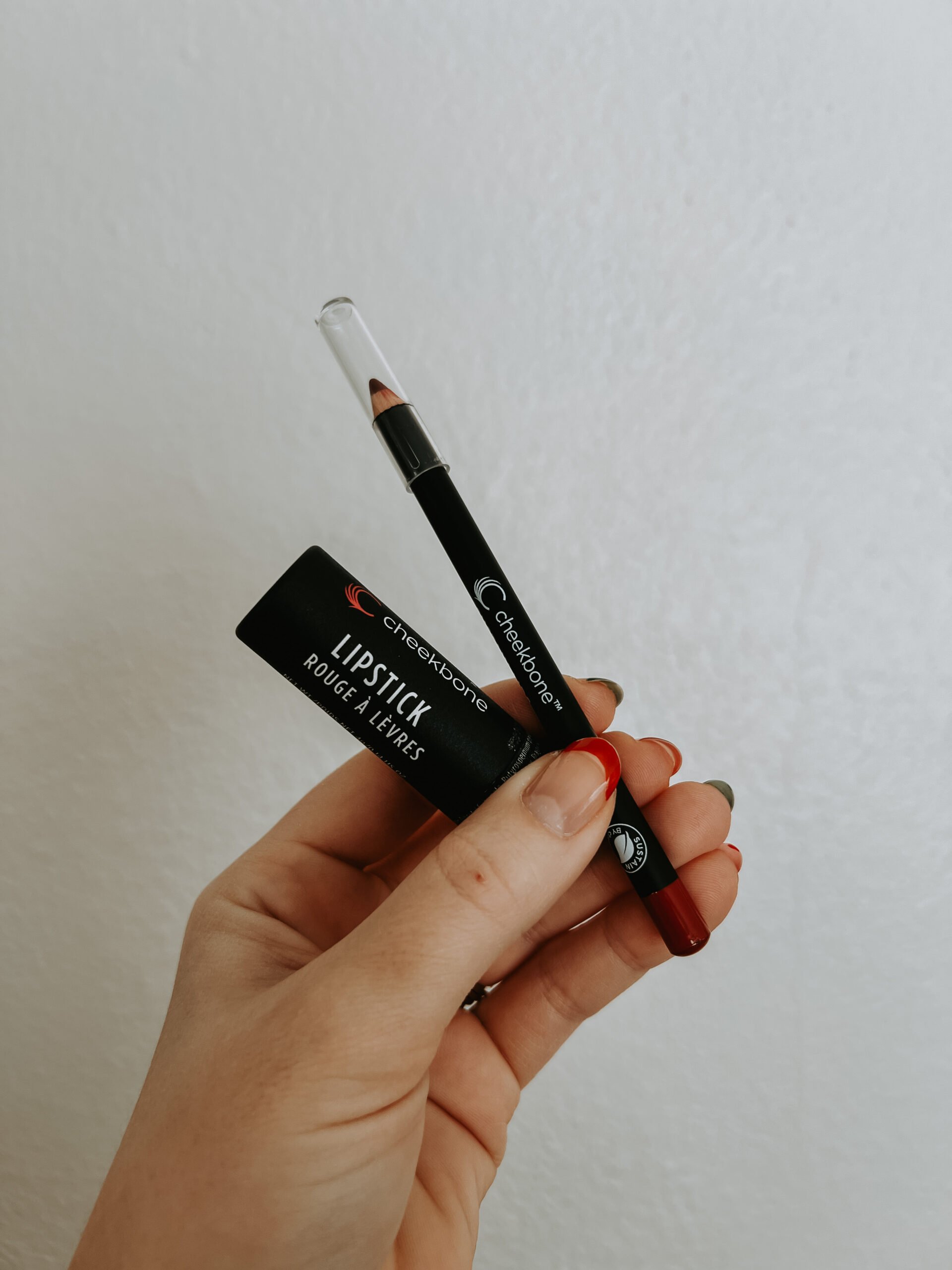
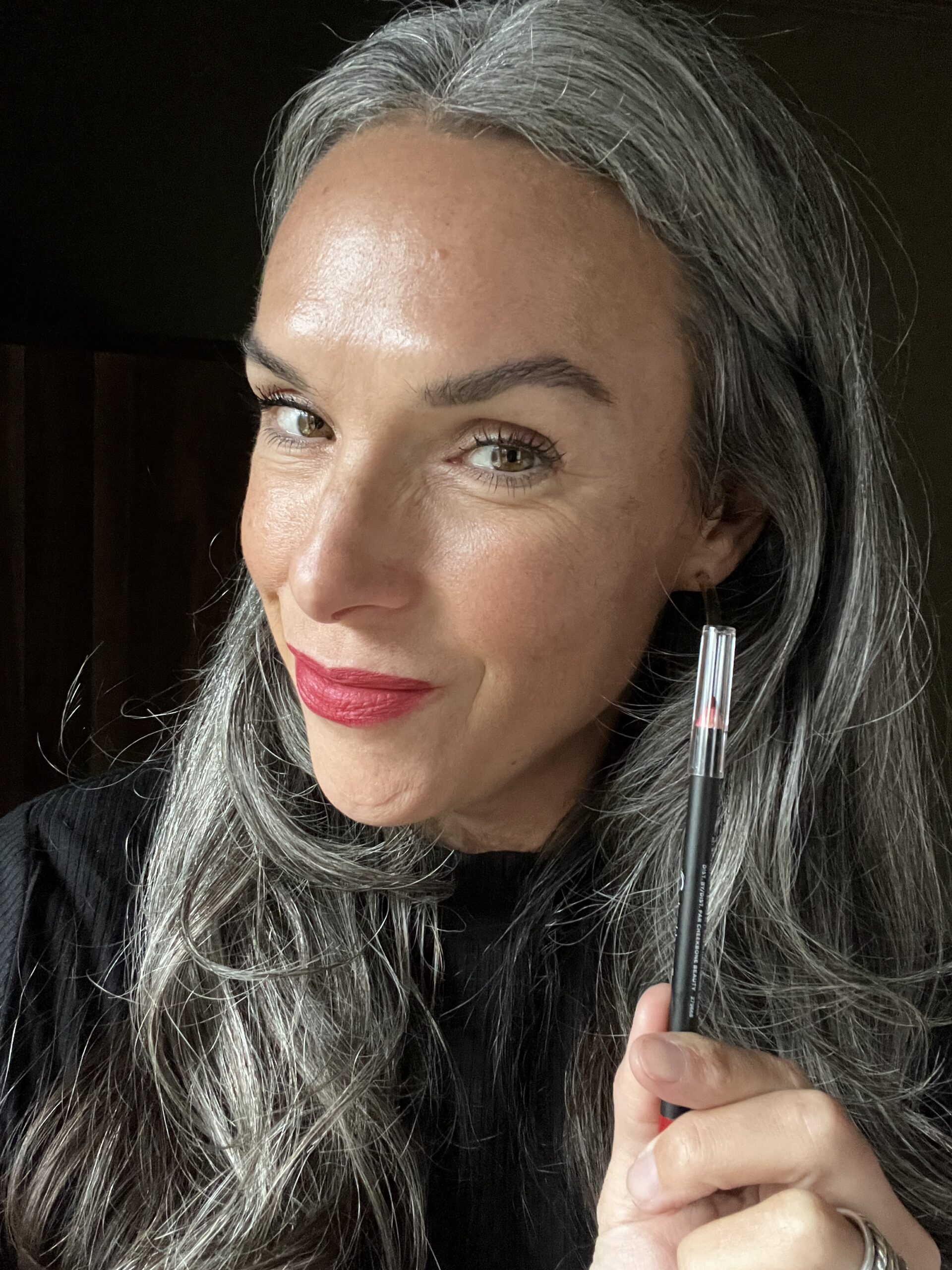
Cheekbone Beauty Lipstick in AKI and Lip Pencil in True Red | $24 & $15
Shade: True, cool red, with a hint of warm brown.
Cheekbone Beauty is an Indigenous-owned and founded Canadian cosmetics company established in 2016. Their aim is to “make a difference in the lives of Indigenous youth through donations addressing the educational funding gap, and to create a space in the beauty industry where Indigenous youth feel represented and seen.”
They focus on high performance and sustainability. Each lipstick shade is named after the earth (or land) in one the the world’s 7,000 Indigenous languages. This shade, AKI (AH-KEE) is the Anishinaabe or Ojibwe language word for land or earth.
Cheekbone Beauty uses a mix of iron oxides, titanium dioxide and synthetic dyes to color their lipsticks, which is why we are seeing a more vibrant red. They also offer lip pencils too. Showing you the difference in color pop between the two in the images above.
What we liked:
- Satin finish
- Packaging is 85% compostable and biodegradable
- The depth of a pencil and lipstick combo in the same shade
- Price
- Color payoff—a nice, true red that can be punched up with layering
- Not drying
What we didn’t like:
- No focus on organic ingredients
Ingredients listed on website: Capryloyl Glycerin/Sebacic Acid Copolymer, Diheptyl Succinate, Euphorbia Cerifera (Candelilla) Wax, Copernicia Cerifera (Carnauba) Wax, Brassica Glycerides, Butyrospermum Parkii (Shea) Butter, Synthetic Fluorphlogopite, Silica, Kaolin, Tocopherol, Glyceryl Caprylate
May Contain (+/-): Titanium Dioxide (CI 77891), Iron Oxides (CI 77491, CI 77492, CI 77499), Red 27 Lake (CI 45410), Blue 1 Lake (CI 42090), Yellow 5 Lake (CI 19140), Red 7 Lake (CI 15850), Red 6 Lake (CI 15850)

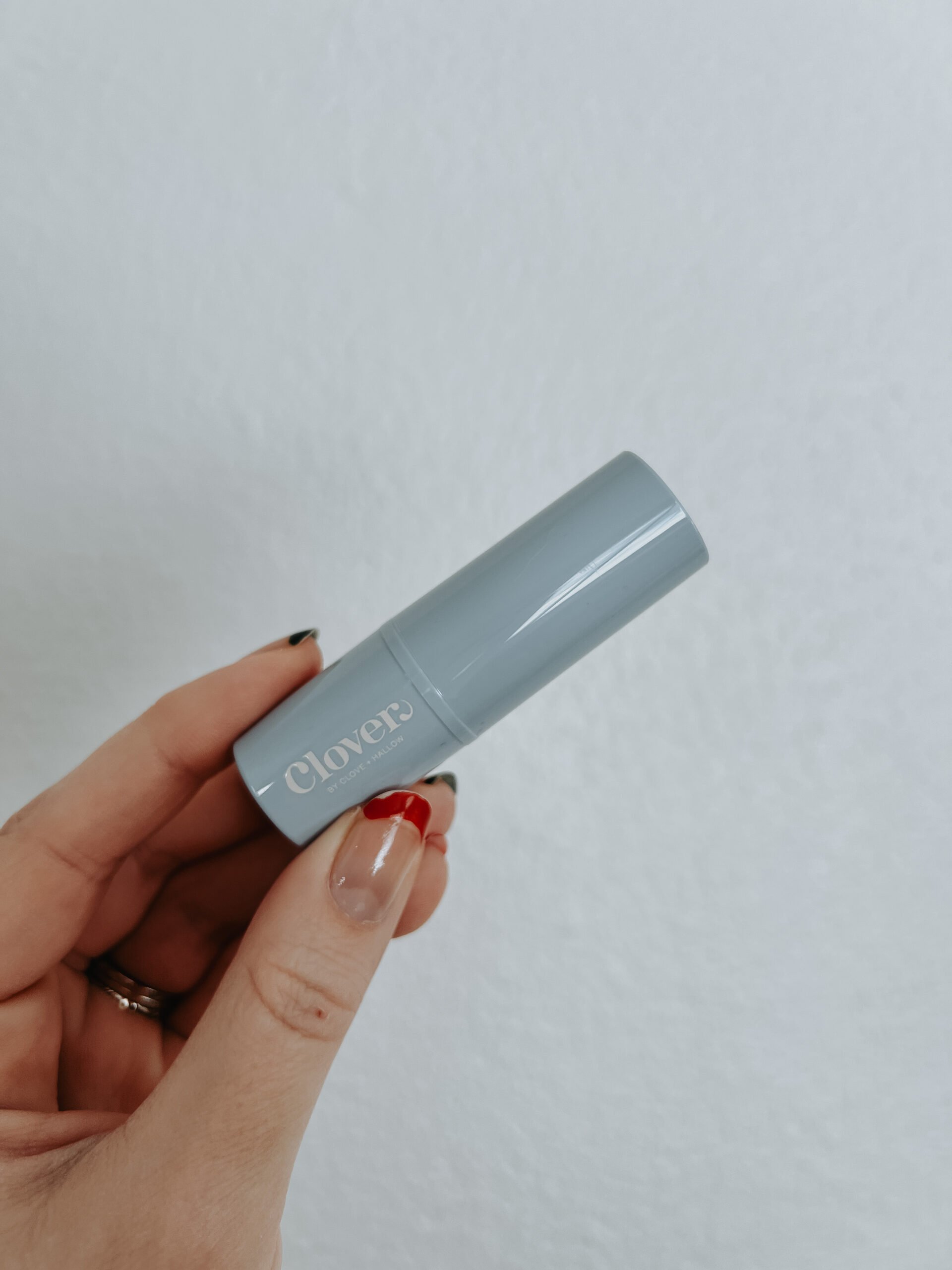
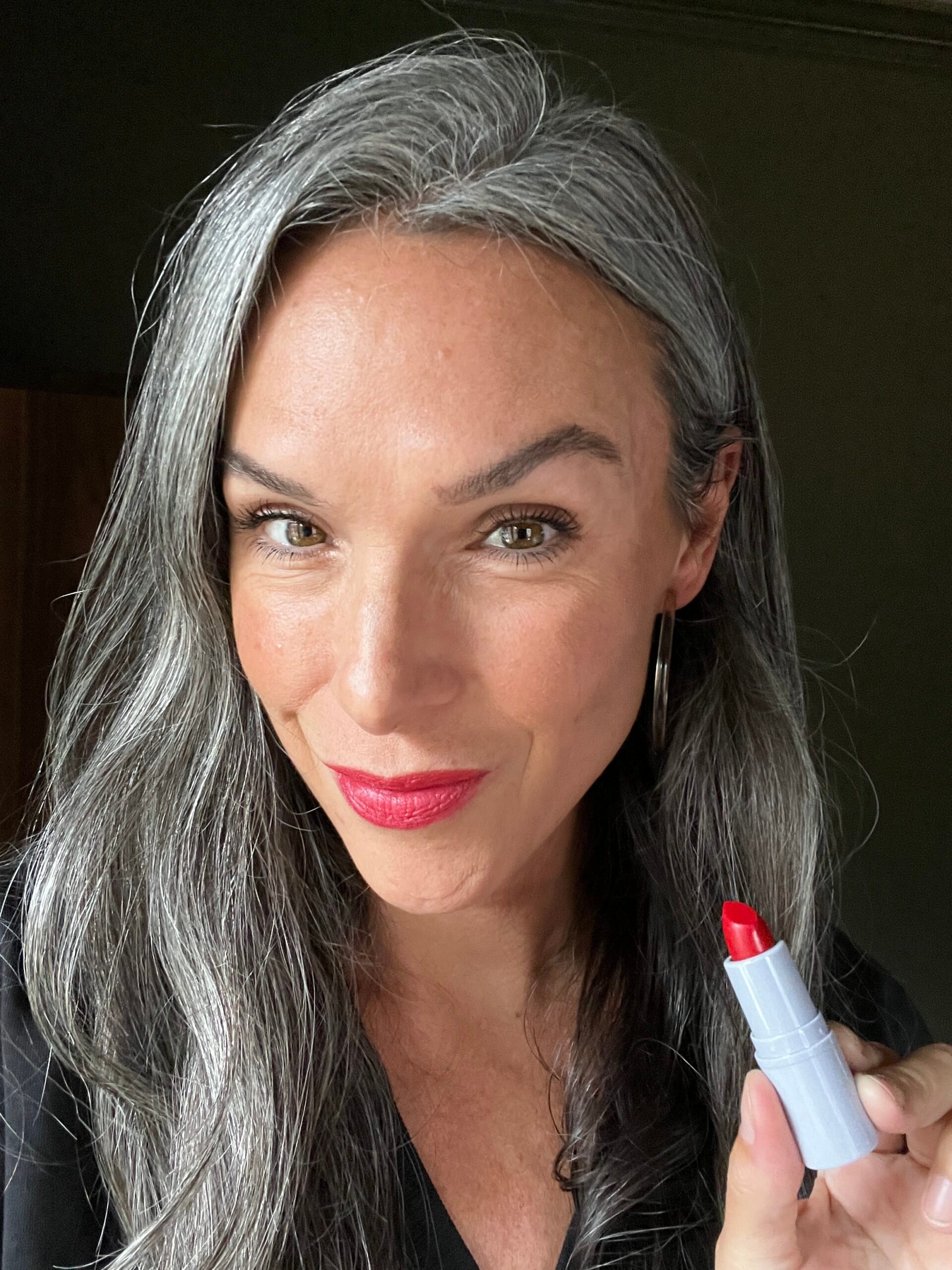
Clover Comfy Matte Lipstick in Retro | $16
Shade: True red, with a hint of warmth
Clover (by Clove + Hallow) brings accessibility and functionality to the clean beauty red lipstick realm. This is the most affordable option we found that still performs. When I wore this shade on social, I got a ton of q’s like “What lipstick is that?!”
Clover uses a mix of synthetic dyes, iron oxides and titanium dioxide to color their lipsticks.
What we liked:
- Price
- Recyclable plastic lipstick tube made from 100% previously recycled plastic
- Easy to apply formula
- No discernible scent
What we didn’t like:
- Not a focus on certified organic ingredients
- While it gives you a lip stain, the stain wears much more pink than red
Ingredients listed on website: Octyldodecanol, Candelilla Wax, Kaolin, Tricaprylin, Sunflower Wax, Polyhydroxystearic Acid, Stearalkonium Bentonite, Olive Oil Unsaponifiables, Triethyl Citrate, Rhus Succedanea Fruit Wax, Rhus Vernicflua Peel Wax, Shorea Robusta Resin, Sorbitan Oleate, Siraitia Grosvenorii Fruit Extract; May Contain Iron Oxides, Titanium Dioxide, Red 7 Lake, Yellow 5 Lake, Red 28 Lake, Blue 1 Lake
Best matte red lipstick

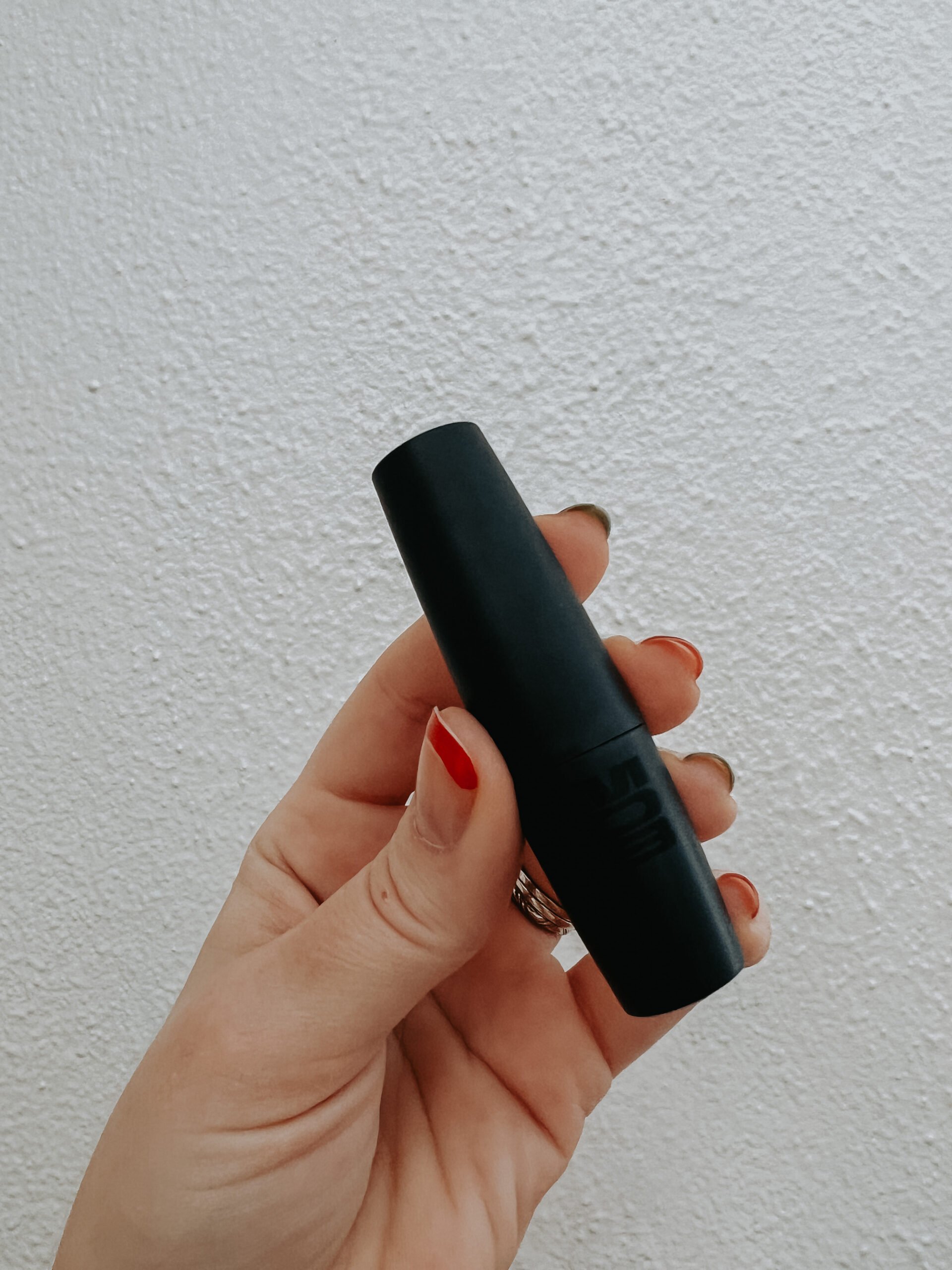
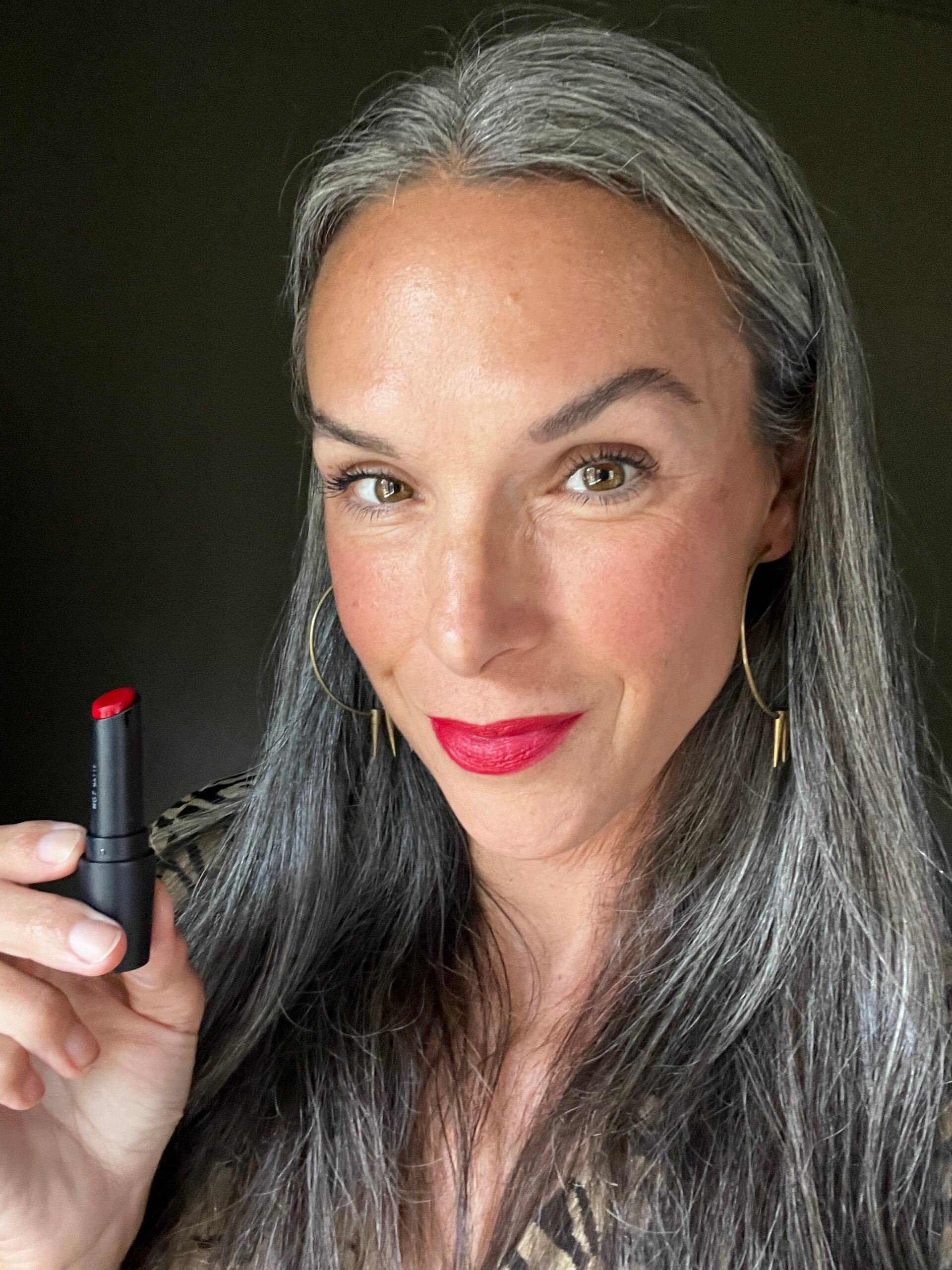
MOB Cream Lipstick in M62 | $22
Shade: True, cool-tone matte red, with a tiny bit of magenta.
MOD uses a mix of iron oxides, titanium dioxide and synthetic dyes to color their lipsticks. This shade wore very magenta on me, but in comparison, it’s more on the true red side than the pink red side. Love that this is a one-swipe formula—you don’t have to build it up the way you do with other shades. Long-wearing and easy to apply.
What we liked:
- Refillable packaging
- Lightweight
- Long-wearing
- Demi to full matte red color
- Doesn’t dry out lips
- Major color payoff
- No discernible scent
What we didn’t like:
- The refillable packaging needs work, as the refill easily pops in and out.
- No focus on organic ingredients
Ingredients listed on website: jojoba esters, tridecyl trimellitate phytosteryl/octyldodecyl lauroyl glutamate, diisostearyl malate, polyhydroxystearic acid, microcrystalline wax, copernicia cerifera (carnauba) wax, cetearyl nonanoate, capryloyl glycerin/sebacic acid copolymer, silica, dilinoleic acid/propanediol copolymer, triacontanyl pvp, n-capryloyl lysine, ethylhexyl palmitate, tocopherol, bisabolol, tetrahexyldecyl ascorbate, phytosphingosine, tribehenin, sorbitan isostearate, limonene, vanillin, ascorbyl palmitate, palmitoyl tripeptide-1, citrus aurantium dulcis (orange) peel oil. May contain: titanium dioxide, iron oxides, yellow 5 lake, yellow 6 lake, red 6 lake, red 7 lake, red 27 lake, red 28 lake, red 30 lake, red 33 lake, blue 1 lake
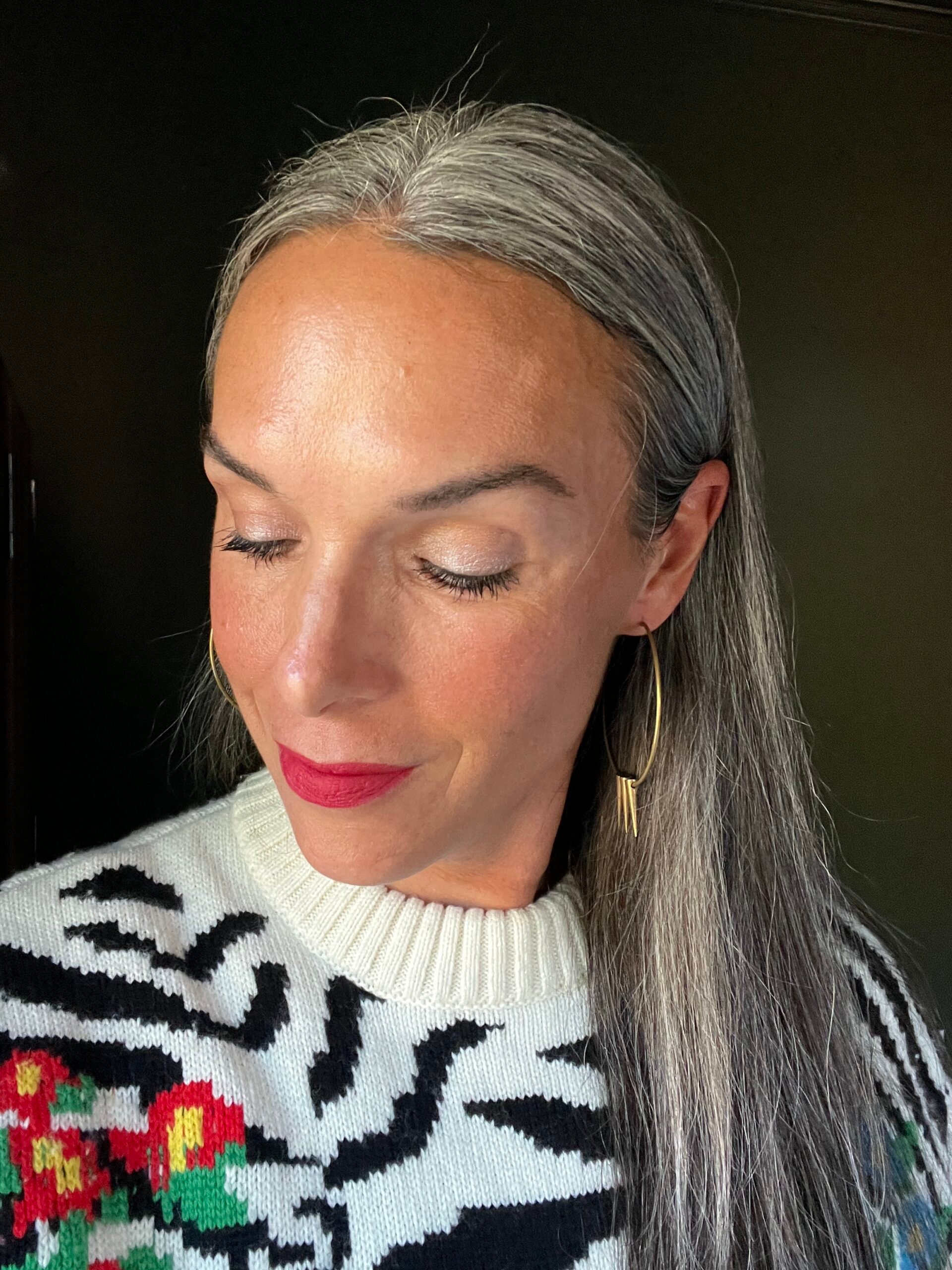
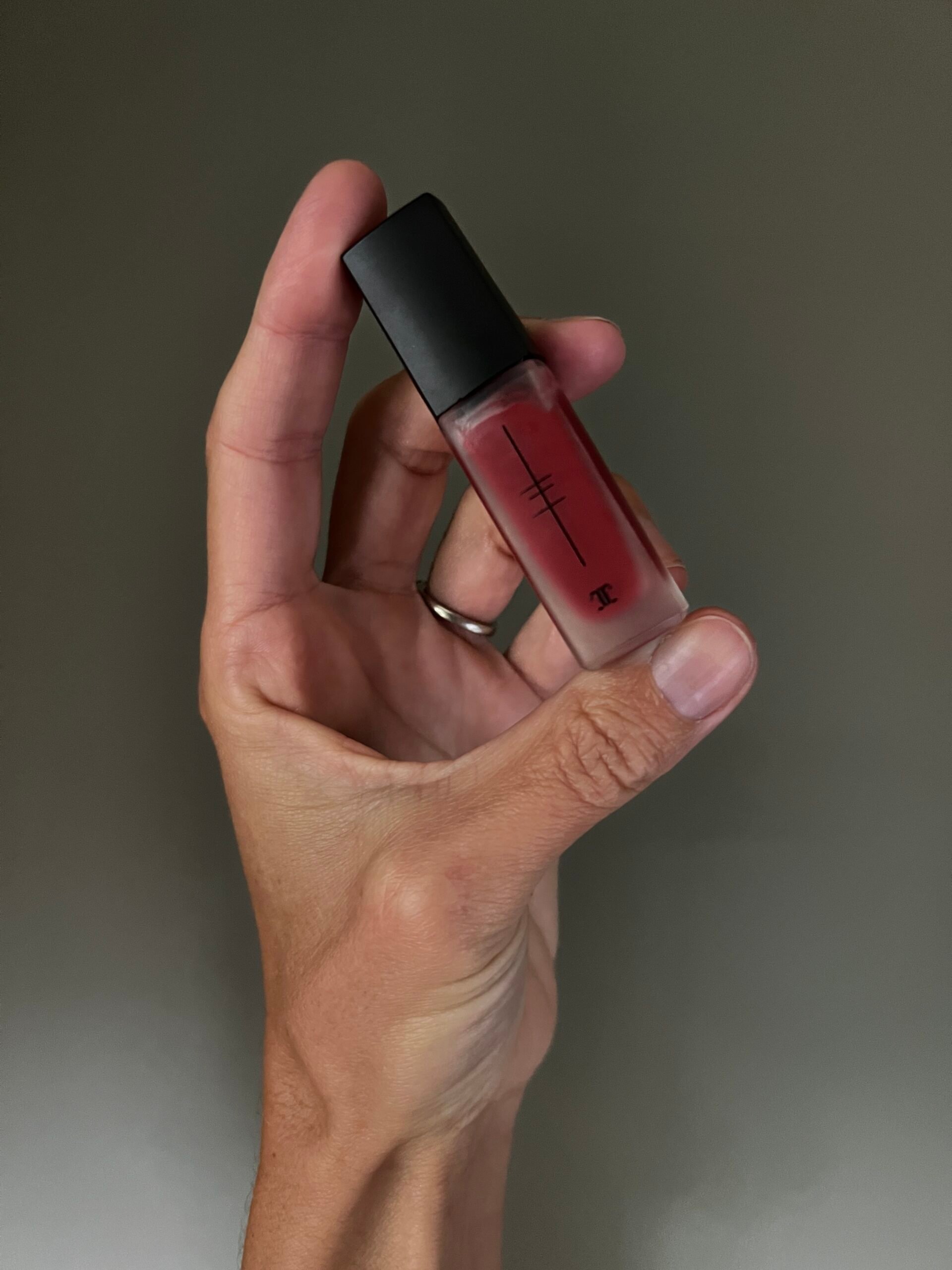
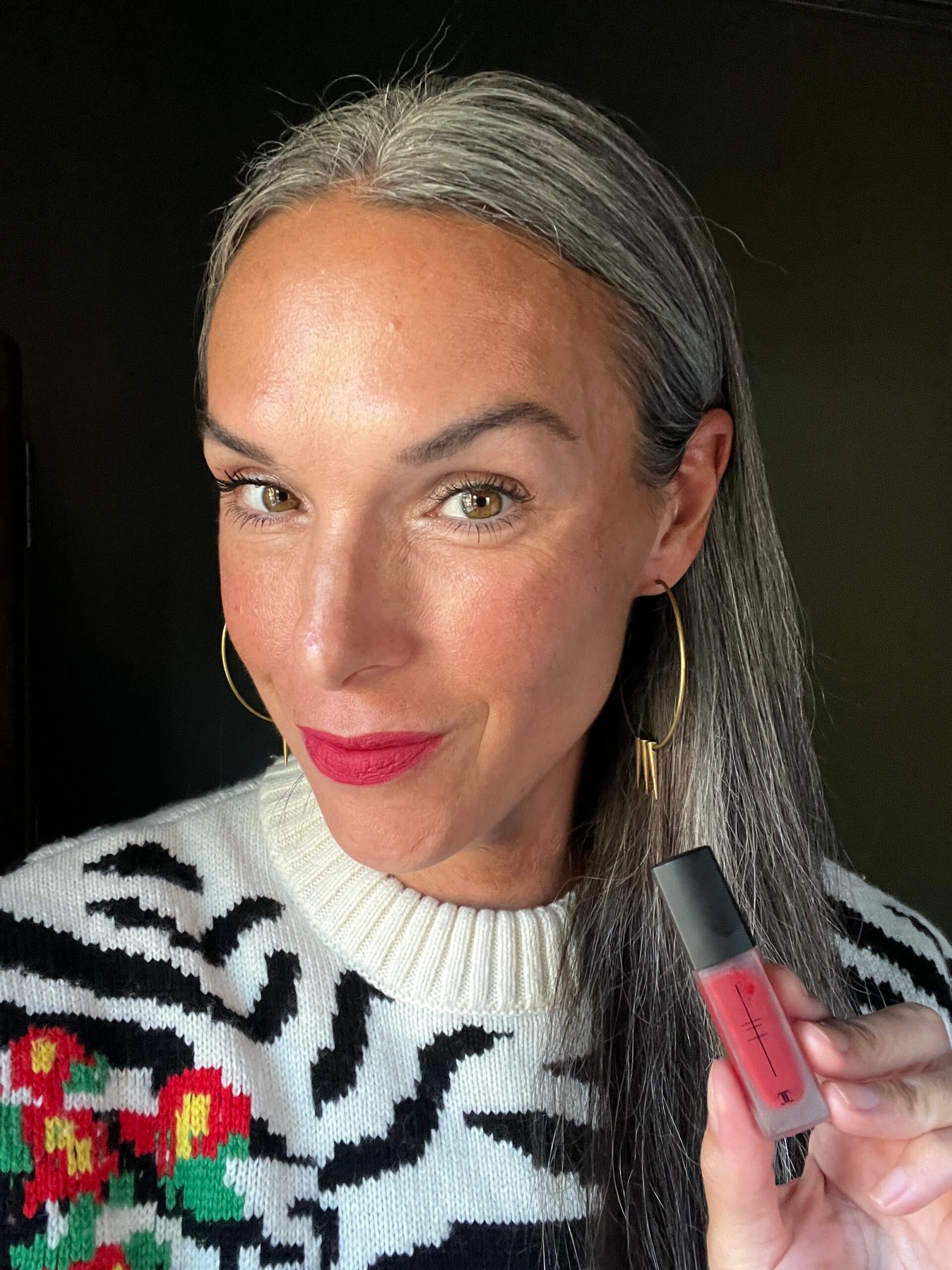
Johnny Concert Maudit in Mon Cheri | $25
Shade: True, full-on matte red.
Jonny Concert says they formulate with organic apricot, passion fruit, hemp seed, and evening primrose oils to help hydrate lips keeping them soft.
Jonny Concert uses a mix of iron oxides, titanium dioxide and synthetic dyes to color their lipsticks. This is the TRUEST matte red on the list and I looooove the look. It dries down so nicely and can almost be considered a lip stain.
What we liked:
- Matte finish
- Almost like a lip stain
- Long wearing
- Some organic ingredients
- Cute packaging
- Packaged in glass
What we didn’t like:
- Can be a little drying
- Can be a little hard to remove
Ingredients listed on website: Coconut Alkanes, Isododecane, Kaolin, Trimethysiloxysilicate, Polypropylsilsesquioxane, Trihydroxystearin, Polyhydroxystearic Acid, Disteardimonium Hectorite, Propylene Carbonate, Coco-Caprylate/Caprate, Cannabis Sativa (Hemp) Seed Oil*, Passiflora Edulis (Passion Fruit) Seed Oil*, Prunus Armeniaca (Apricot) Kernel Oil*, Oenothera Biennis (Evening Primrose) Oil*, Helianthus Annuus (Sunflower) Seed Wax, Vanillin, Xylityl Caprate/Caprylate*. May Contain (+/-): Titanium Dioxide (CI 77891), Iron Oxides (CI 77492) (CI 77491) (CI 77499), Tin Oxide (CI 77861), Red 7 Lake (CI 15850), Red 6 Lake (CI 15850), Red 28 Lake (CI 45410), Yellow 5 Lake (CI 19140), Blue 1 Lake (CI 42090).
What’s your go to red lipstick?
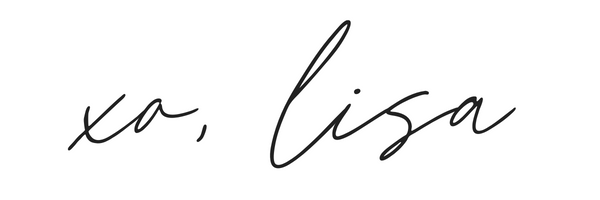
TNK Team Note: This article contains affiliate links. TNK uses affiliate links as a source for revenue to fund operations of the business and to be less dependent on branded content. TNK stands behind all product recommendations. Still have questions about these links or our process? Feel free to email us.
References
1. Kobylewski, Sarah; Jacobson, Michael F; Toxicology of food dyes; International Journal of Occupational and Environmental Health July 2012.
2. Taylor, S.L.; Baumert, J.L.; Encyclopedia of Agriculture and Food Systems, 2014.
3. Nomination background D &C red no. 27 [CASRN 13473-26-2], D&C Red No. 28 [CASRN 18472-87-2]; National Institutes of Health, October 2000.
4. Food dyes; Center of Science in the Public Interest, 2008.

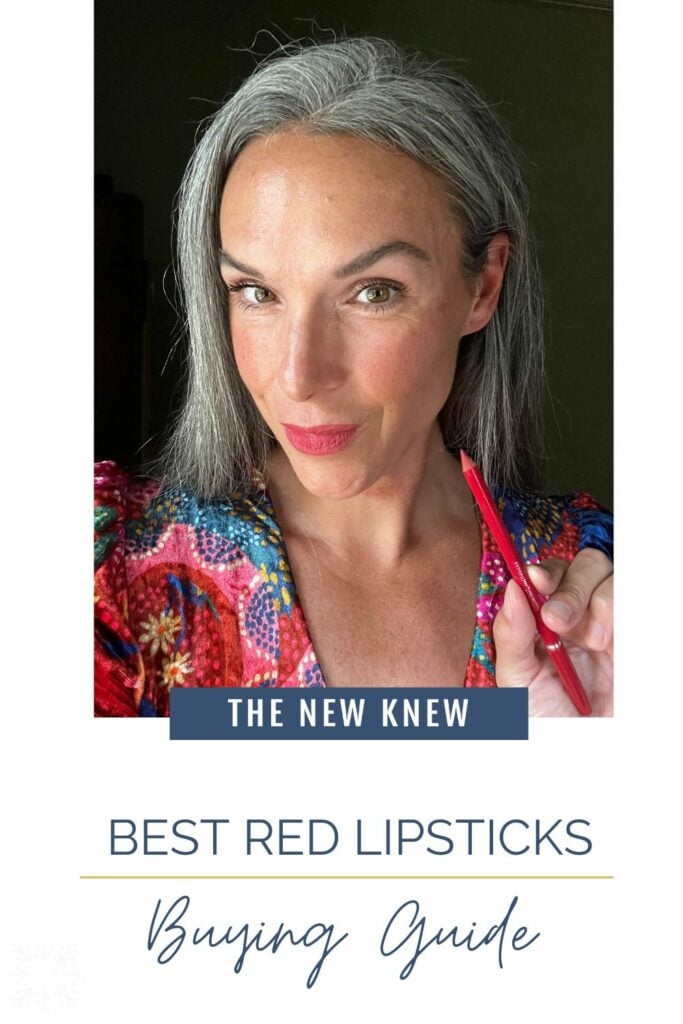
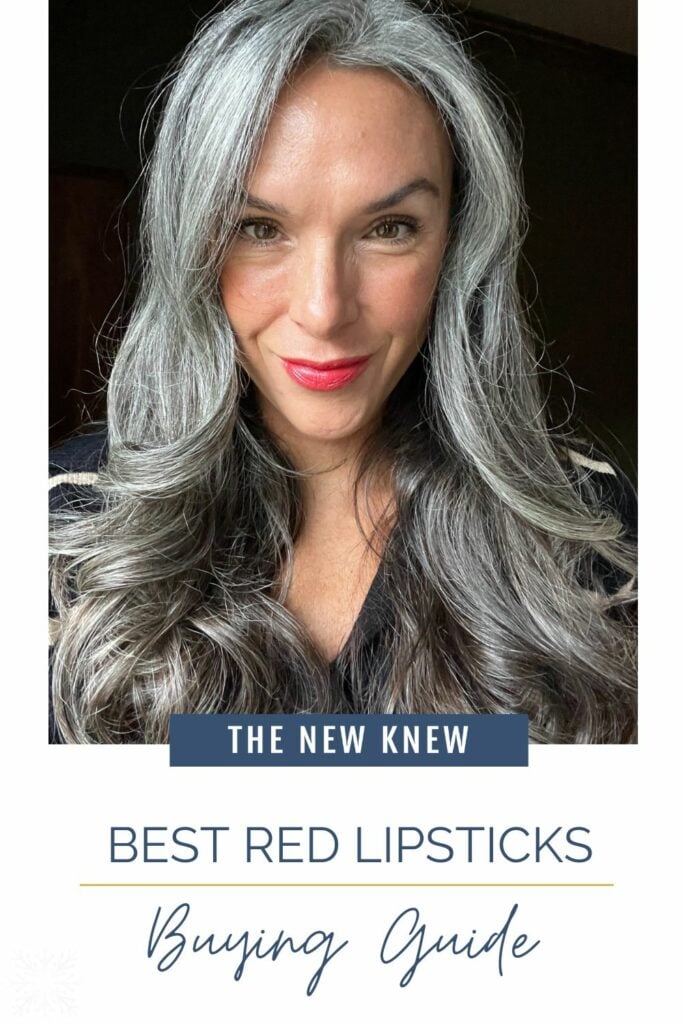
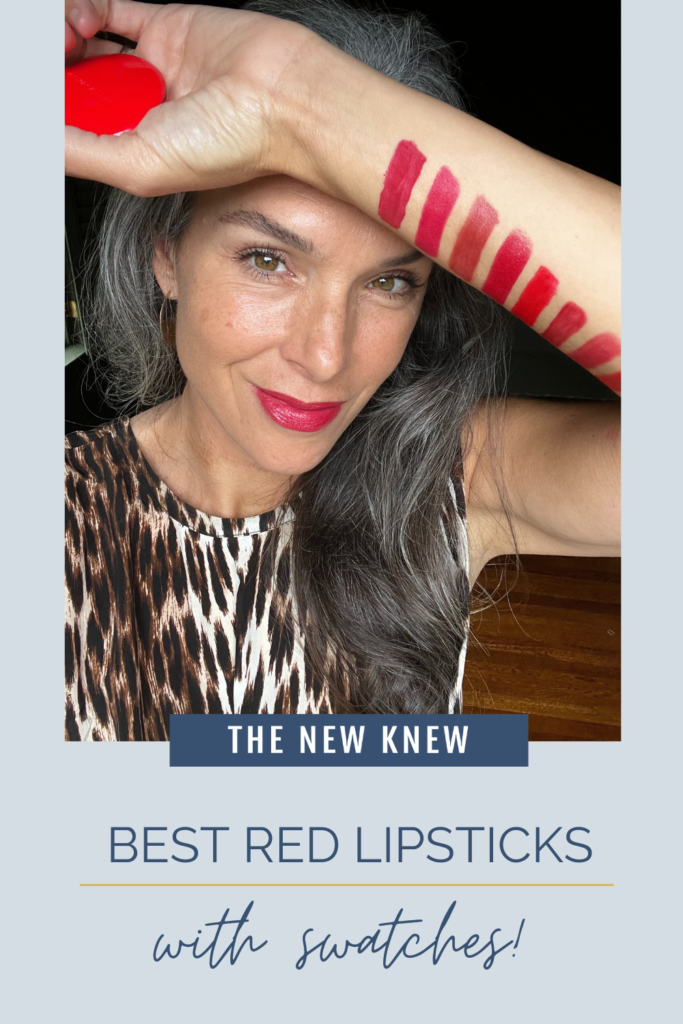
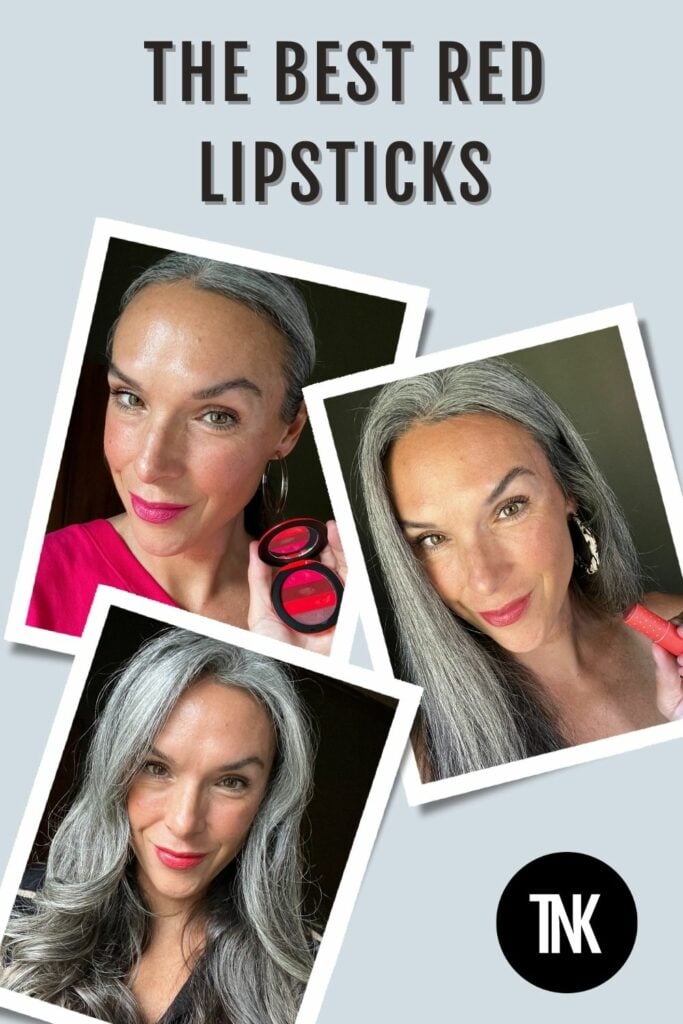
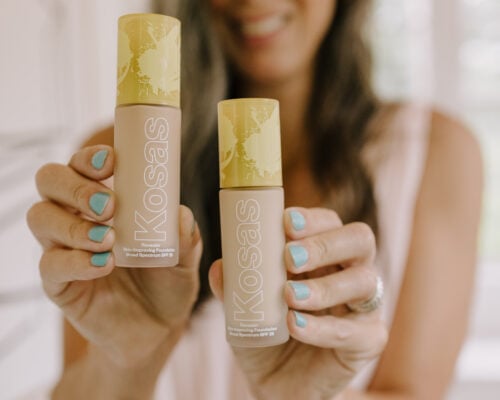

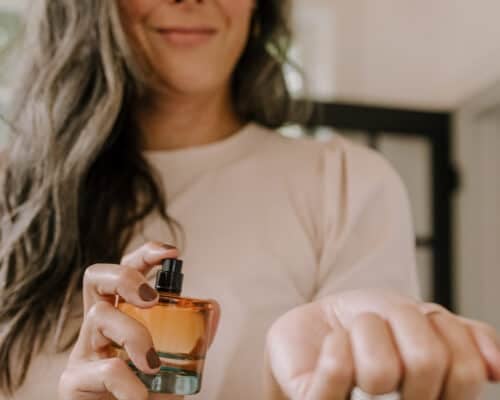
Sarah P
March 15, 2023Colour is different on everyone, so I’m not sure how useful it is to focus on that. I’d like to see much more emphasis on performance – whether it rubs off, settles into lines around the mouth etc. Which products required lip liner to stay put and what liner did you use to colour match? On that note, how well did the liner perform? More attention to finish (gloss or matte) would be helpful too. Some of the clean brand red lip products I have tried were so bad that I wouldn’t even describe them as a cosmetic product – colour bled within minutes into the most awful mess around the mouth.
Lisa Fennessy
April 17, 2023Thanks for this Sarah – good points! Lisa